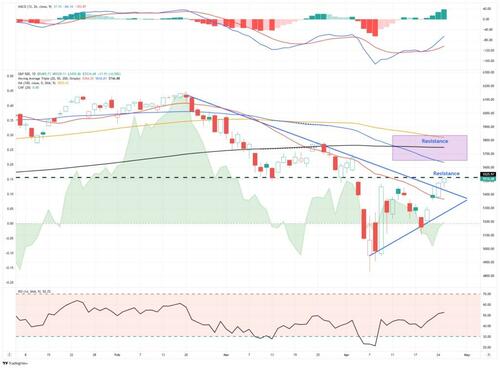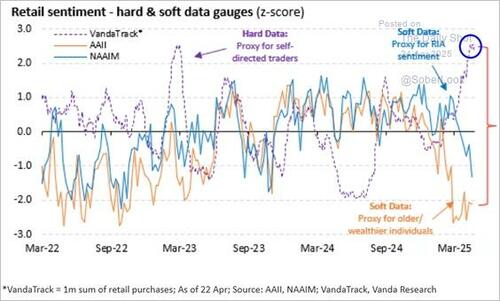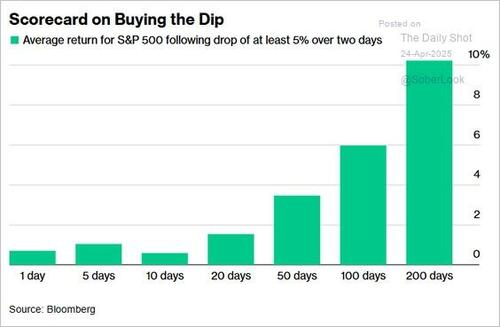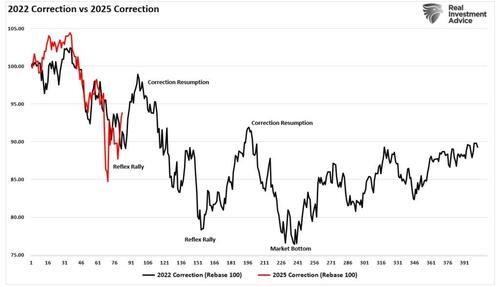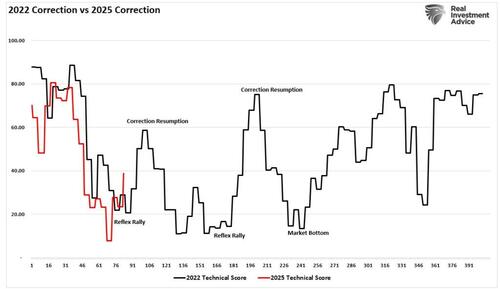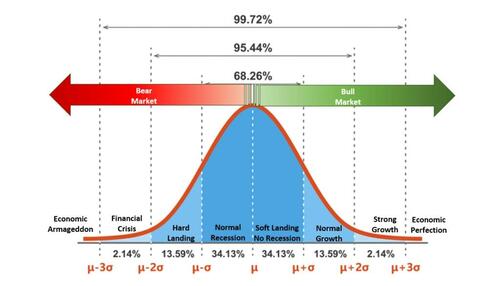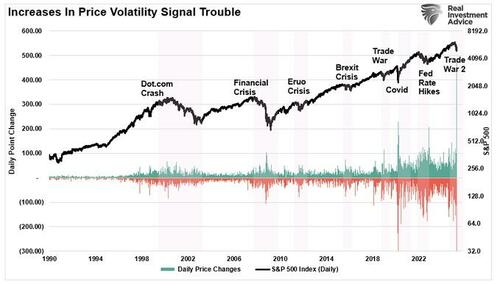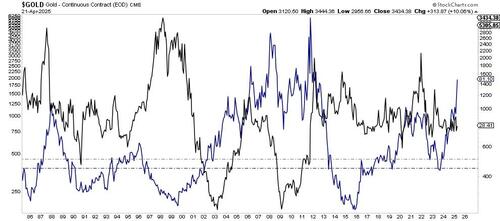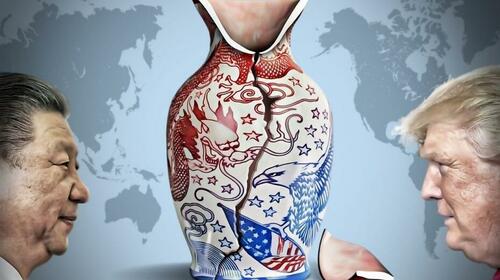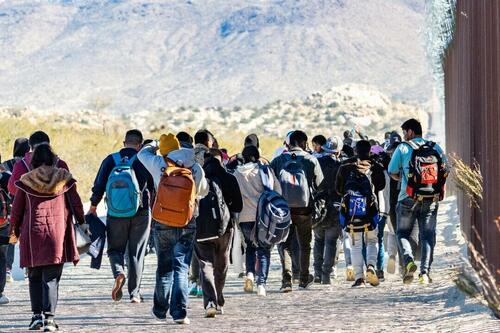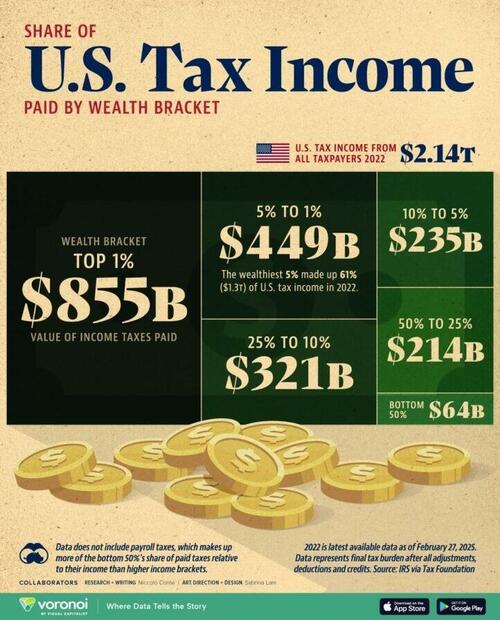That Christianity gives joy and breadth is also a thread that runs through my whole life. Ultimately someone who is always only in opposition could not endure life at all.
Distinction Matter - Subscribed Feeds
-
Site: Zero HedgeTexas Governor Signs 'Texas DOGE' Into Law To Cut Regulations, Boost Government EfficiencyTyler Durden Sun, 04/27/2025 - 11:40
Authored by Chase Smith via The Epoch Times (emphasis ours),
Texas Gov. Greg Abbott signed into law on April 23 a sweeping regulatory reform measure known as the Regulatory Reform and Efficiency Act, aimed at streamlining government processes and reducing the regulatory burden on businesses and residents.
 Texas Gov. Greg Abbott signs the newly introduced Senate Bill 14 in the State Capitol in Austin on April 23, 2025. Brandon Bell/Getty Images
Texas Gov. Greg Abbott signs the newly introduced Senate Bill 14 in the State Capitol in Austin on April 23, 2025. Brandon Bell/Getty Images
Senate Bill 14 creates the Texas Regulatory Efficiency Office within the Office of the Governor and has been characterized as the Texas version of the federal Department of Government Efficiency (DOGE) created by President Donald Trump and led by businessman Elon Musk.
The new office is tasked with identifying outdated or duplicative rules, assisting state agencies in simplifying regulatory procedures, and establishing public access to rulemaking processes through a centralized online portal.
“We are putting at the forefront of legislation the shaping, formation, and recalibration of government in the State of Texas to make it more responsive and more efficient,” Abbott said in a statement. “We in Texas will now have our own DOGE, known as the Texas Regulatory Efficiency Office. This law will slash regulations, put stricter standards on new regulations that could be costly to businesses, and put a check on the growth of the administrative state.”
The governor added that the office would make the government more efficient and less costly and that the state would operate “at the speed of business.”
The bill also establishes a Texas Regulatory Efficiency Advisory Panel composed of members of the business community, academia, and regulatory law to support the office’s mission. The new office will produce regulatory analysis manuals and reduction guides, and coordinate with other state entities to improve transparency and consistency.
Abbott said the measure is important for the state’s economic health and limiting regulations.
“Texas has won the national championship for economic development for 13 years in a row—business could not be doing better,” Abbott said in remarks while signing the bill. “With one exception. Among the CEOs that I talked to every single week, there were growing concerns that were repeated time and again. The regulatory environment in Texas is getting too burdensome.”
Abbott added that although Texas is generally known as business-friendly when it comes to regulations, the regulatory environment was “not as easy to navigate as it once was.” He cited a 2024 study that showed Texas had the fifth-highest regulatory burden of any state.
Critics of the bill questioned why it was necessary, as there is already a state Sunset Advisory Commission. According to its website, the mission of that agency is “to enhance government accountability to the Legislature and people of Texas by objectively evaluating the need for and value of state programs and services.”
Republican state Rep. Brian Harrison, who voted against the bill, said in a post on X after the governor signed the bill that it “grows government, increases spending, expands bureaucracy, gives more power to the executive branch, protects the Chevron deference, and makes Texas courts more liberal than federal courts.”
In a speech on the House floor earlier in the session, Harrison said: “The point of DOGE is to cut government, reduce spending, and shrink the bureaucracy. Unfortunately, this bill does the exact opposite.”
Republican Lt. Gov. Dan Patrick dubbed the measure “DOGE Texas-style,” and said it is about cutting red tape and saving taxpayer dollars.
“Texas DOGE will ensure the Texas Miracle continues long into the 21st century,” Patrick said in a statement. “Texans understand that by cutting red tape, more money stays in the pocket of taxpayers. Our conservative approach to regulation will keep Texans prosperous and our state the best place to do business in America and across the globe.”
Speaker of the Texas House Dustin Burrows, also a Republican, called the law a win for transparency and government accountability.
“A major theme of this session is government efficiency, and today the state is delivering on its promise to cut red tape and empower Texans with greater oversight of their government,” Burrows said in the statement. “As the first bill signed by Governor Abbott into law this session, the Regulatory Reform and Efficiency Act brings our state into the 21st century in terms of government rulemaking and will strengthen economic opportunity.”
The law includes provisions for a biennial report from the office to state leadership and a mandate for rulemaking procedures to be written in plain language. It also removes judicial deference to agency interpretations of law in many court cases, allowing judges to review agency rulemaking.
Jeff Burdett, state director for the National Federation of Independent Business, called the bill “a historic step for Texas small businesses.” Glenn Hamer, president and CEO of the Texas Association of Business, said the law follows key recommendations from the Governor’s Small Business Freedom Council and called it “a model for the nation.”
-
Site: Zero HedgeSome 150 Drones Target Ukraine As Trump Doubts Putin On Peace: "Just Tapping Me Along"Tyler Durden Sun, 04/27/2025 - 11:05
Overnight into Sunday Russia launched a massive wave of drones on Ukraine, which targeted several regions, resulting in at least one person killed and a 14-year-old girl wounded in the city of Pavlohrad in the Dnipropetrovsk region
Another person was wounded in the Odessa region, and in all there were around 150 drones sent, with Ukraine's air force saying it was able to intercept or electronically jam 67 of them.
 Illustrative file image
Illustrative file image
Given that such drone and missile attacks have remained frequent, even as there's a US-led effort to get peace talks off the ground, Ukraine's military has been trying to target drone manufacturing hubs inside Russia with its own strikes
On Wednesday the General Staff of Ukraine's Armed Forces said that "a strike had successfully hit a drone manufacturing facility in the Yelabuga district of Russia's Republic of Tatarstan, located some 655 miles from Ukraine's border."
"The armed forces said Ukraine's Unmanned Systems Forces struck the facility, which produces about 300 different combat drones per day, including Iranian-designed Shahed drones, and the Russian-made versions, known as Geran uncrewed aerial vehicles (UAVs)," Newsweek reported.
Trump on Friday said Ukraine and Russia were "very close to a deal" but has also of late expressed skepticism over Moscow's willingness, and has warned that the Russian side better not drag its feet to buy more time to advance on the battlefield.
"There was no reason for Putin to be shooting missiles into civilian areas, cities and towns, over the last few days," Trump wrote in a social media post after attending the funeral for Pope Francis.
Trump and Zelensky had an impromptu face-to-face meeting inside St. Peter's Basilica on the sidelines of the funeral. The NY Times suggests that Zelensky was able to make progress in winning Trump over:
President Trump’s standing among Ukrainians is practically on life support. But many cheered one statement he made on Saturday after meeting with President Volodymyr Zelensky, questioning why President Vladimir V. Putin of Russia would continue to pummel Ukraine as the United States is trying to broker peace talks.
“It makes me think that maybe he doesn’t want to stop the war, he’s just tapping me along,” Mr. Trump wrote on Truth Social after meeting with Mr. Zelensky on the sidelines of Pope Francis’ funeral, adding that Mr. Putin may need to be “dealt with differently” — with more sanctions.
The Ukrainian side is hoping this has restored positive relations between the two leaders, given it was their first meeting since the blowup and damaging encounter in the Oval Office on Feb.28.
Trump on Truth Social: It makes me think that maybe he doesn't want to stop the war, he's just tapping me along, and has to be dealth with differently, through "Banking" or "Secondary Sanctions?" Too many people are dying!!!
Had anyone heard the expression "tapping me along" before Trump started to use it to express his frustration and impatience with Iran and Russia? https://t.co/wklP6953m7
— Michael Tracey (@mtracey) April 26, 2025"Even such a small thing as Mr. Trump’s short meeting with Mr. Zelensky felt like a major change," NY Times continued. "Since taking office, the Trump administration has at times appeared almost solicitous of Mr. Putin, a sharp reversal in U.S. policy. And Mr. Trump has made no secret of his dislike for the Ukrainian leader."
-
Site: Zero HedgeSpock And The Logic-Based Approach To VolatilityTyler Durden Sun, 04/27/2025 - 10:30
Authored by Lance Roberts via RealInvestmentAdvice.com,
Market Finds Some Hope
Last week, we discussed the issue with the spat between President Trump and the Federal Reserve chairman, Jerome Powell. As noted then:
“While the markets await the next Federal Reserve meeting, the uncertainty over monetary policy weighs on markets as much as the uncertainty about tariffs. This past week, the market reversed some of its gains from the massive “tariff reprieve” surge. With the MACD back on a buy signal and money flows turning positive, buyers are tepidly stepping back into the market. The 20-DMA continues to act as overhead resistance, defining the current downtrend. While there is undoubtedly a risk of another test of recent lows, which should be expected and why caution remains advisable, a break above the 20-DMA would lead to a rally to the 50-DMA. (Monday’s article addressed the “Death Cross” and what it means for investors.)“
The market rallied above the 20-DMA this past week as investors found some “silver linings” to the ongoing tariff dispute. Despite China saying “no negotiations” had started with the U.S., comments from both President Trump and Scott Bessent suggested that the Administration would “be nice” to China and that a “very good deal” could be done between the two countries. As we have noted previously, given the more extreme oversold condition of the market, any “good news” would allow investors to push stocks higher.
As stated, the market cleared initial resistance at the 20-DMA, but there is a heavy band of resistance just ahead at the level where the market was trying to bottom ahead of the tariff announcements. Just above that is the confluence of the 50- and 200-DMAs. While markets are not overbought yet, sellers will likely re-emerge if the market pushes further into those resistance levels. As we have suggested over the last two weeks, we are likely in for a rather protracted consolidation action as the market digests ongoing trade negotiations, slower economic growth, and reduced earnings expectations. Therefore, we should expect continued pullbacks and rallies until the market resolves the seller imbalances.
What is very interesting about the recent market decline is that while professional and “older investors,” who are presumably more experienced, are very “bearish” about their investment outlook, retail investors have been “buying the dip” at the most on record going back to early 2023.
However, while you may shake your head in disbelief, buying markets when they are down has been an essentially winning strategy for dip buyers over the last decade. Of course, such should be unsurprising given repeated rounds of monetary and fiscal interventions. As previously discussed, the Fed has engendered an entire generation of young investors with a sense of “moral hazard.” To wit:
“From a market perspective, the liquidity flows from the Federal Reserve increased speculative appetites and investors piled into “zombies” with reckless abandon. Why? Because of a lack of incentive to guard against risk as investors believe the Fed is protecting them from the consequences of risk. In other words, the Fed has “insured them” against potential losses.”
Will this time be different? Maybe. There will be a point where taking on excessive speculative risk in leveraged ETFs and options leads to poor outcomes. However, that may not be today. As such, we need to be mindful that buyers and sellers drive markets. Until the markets change investors’ speculative attitudes, we will likely continue to find support in markets even though we may think there shouldn’t be.
Such is the message of today’s discussion: learning to be “unemotional” when managing our money.
Spock And The Vulcan Approach To Investing
In “Is Risk Off Positioning Signaling A Market Low,” we discussed the extremely oversold market conditions that are beginning to suggest the market may be approaching a near-term low. That analysis was based on various indicators, including extremely negative investor sentiment, positioning, and technical oversold conditions. As we stated, the current market environment is much like 2022. The first chart below shows the 2022 market correction versus 2025. The rally that began this past week could certainly rally further. Still, as we have warned, any rally in the near term will likely be met with sellers until there is a resolution on tariffs, monetary policy, and more certainty around recession risks.
The following chart compares our weekly Technical Composite Index. You will note that the market bounced or bottomed when the technical composite reached below 20.
The current conundrum is whether the extremely low technical readings preceding this week’s rally were a technical bounce or a market bottom. Unfortunately, we won’t know until after the fact. Still, our gut instinct suggests that given the depth of the decline and the technical damage to the market overall, any significant bounce will be met with sellers. Historically, the first market low during a correction phase is not usually a bottom. Regardless, the market continues to follow the 2022 playbook closely this year, but I would not expect the rest of the year to be an exact match.
The optimistic view is that while there are never any guarantees when it comes to investing, history suggests that after such a volatile period, we tend to perform better in the future, barring the onset of a recession or credit-related event. The bad news is that these increases in volatility tend to lead investors to make many emotionally driven investment mistakes. We rationalize, try to avoid losses, fail to take action when needed, or take action when we shouldn’t—all driven by our emotions. Yet being unemotional about your money is crucial to long-term investment outcomes.
As Howard Marks once stated:
“If I ask you what’s the risk in investing, you would answer the risk of losing money. But there actually are two risks in investing: One is to lose money, and the other is to miss an opportunity.
You can eliminate either one, but you can’t eliminate both at the same time.
So the question is how you’re going to position yourself versus these two risks: straight down the middle, more aggressive or more defensive.
I think of it like a comedy movie where a guy is considering some activity. On his right shoulder is sitting an angel in a white robe. He says: ‘No, don’t do it! It’s not prudent, it’s not a good idea, it’s not proper and you’ll get in trouble’.
On the other shoulder is the devil in a red robe with his pitchfork. He whispers: ‘Do it, you’ll get rich’. In the end, the devil usually wins.
Caution, maturity and doing the right thing are old-fashioned ideas. And when they do battle against the desire to get rich, other than in panic times the desire to get rich usually wins. That’s why bubbles are created and frauds like Bernie Madoff get money.
How do you avoid getting trapped by the devil?
I’ve been in this business for over forty-five years now, so I’ve had a lot of experience. In addition, I am not a very emotional person. In fact, almost all the great investors I know are unemotional. If you’re emotional then you’ll buy at the top when everybody is euphoric and prices are high. Also, you’ll sell at the bottom when everybody is depressed and prices are low. You’ll be like everybody else and you will always do the wrong thing at the extremes.
Therefore, unemotionalism is one of the most important criteria for being a successful investor. And if you can’t be unemotional you should not invest your own money, period. Most great investors practice something called contrarianism. It consists of doing the right thing at the extremes which is the contrary of what everybody else is doing. So unemtionalism is one of the basic requirements for contrarianism.”
If you didn’t read that quote carefully, I would reread it.
During periods of market volatility, investors often let emotions drive decisions. However, the investors who perform best under pressure tend to think less like adrenaline-fueled traders and more like Spock from Star Trek. Emotionless, logical, and consistent, Spock’s mindset offers guidance for navigating turbulent markets. As he once said, “Insufficient facts always invite danger.” That mindset is exactly what investors need when fear or greed threaten sound decision-making. Here are some points to consider.
Emotion Is The Enemy of Reason
Market volatility heightens stress, which in turn amplifies emotional responses. As a result, investors often chase rallies or panic-sell during drawdowns. Spock’s detachment offers a counterpoint.
“When you eliminate the impossible, whatever remains, however improbable, must be the truth.”
Investing means cutting through noise, avoiding speculation, and relying on data. For example, the media is jammed with emotionally charged headlines about tariff-induced trade wars, recessions, and de-dollarization. In reality, those events rarely occur. As we discussed in “Probabilities vs Possibilities:”
“The chart below is a normally distributed “bell curve” of potential events and outcomes. In simple terms, 68.26% of the time, typical outcomes occur. Economically speaking, such would be a normal recession or the avoidance of a recession. 95.44% of the time, we are most likely dealing with a range of outcomes between a reasonably deep recession and standard economic growth rates. However, there is a 2.14% chance that we could see another economic crisis like the 2008 Financial Crisis. But what about “economic armageddon?” That event where nothing matters but “gold, beanie weenies, and bunker.” That is a 0.14% possibility.”
This concept of possibilities versus possibilities is crucial to navigating investment outcomes. Spock never claimed to predict the future. Instead, he calculated the probabilities of potential outcomes. That approach mirrors sound portfolio management. Rather than trying to guess what markets will do tomorrow, successful investors assess various outcomes and plan accordingly. As Spock once stated
“Change is the essential process of all existence.”
In other words, if your current reaction to recent market volatility is to expect it to continue indefinitely, you will likely be disappointed. This is why we continually suggest managing risk, rebalancing, taking profits, and focusing on allocations. Building portfolios that account for downside risks, multiple economic scenarios, and margin of safety allows investors to remain calm when markets shift. The only thing investors need to fear is fear itself.
Emotional decisions typically underperform disciplined ones. Investors can’t eliminate volatility, but can control their reactions to it. Behavioral finance confirms this. Loss aversion, herd behavior, and recency bias drive many of the worst investment decisions.
Discipline Outperforms Reactivity
Reacting emotionally to short-term moves often destroys long-term returns. Spock’s strength was never his speed, but his steadiness.
“Logic is the beginning of wisdom, not the end.”
The ability to step back, re-evaluate with clarity, and follow a predetermined investment process keeps portfolios aligned with goals. Legendary investor Charlie Munger confirmed this view when he stated:
“The big money is not in the buying and selling, but in the waiting.”
Patience is a strategic advantage. During volatile markets, as we have currently, it is crucial to step back and focus on the broad performance of the portfolio relative to your goals. A disciplined approach before volatility sets in is the key to navigating outcomes. Spock’s analytical mindset lends itself to rigorous risk assessment. He didn’t avoid danger; he quantified and prepared for it. Likewise, investors must separate perceived risk from actual risk. Volatility may feel like danger, but it is often simply price movement around a trend. Actual risk lies in permanent capital loss, overconcentration, or misalignment with one’s time horizon and objectives.
As we discussed previously, volatility begets volatility. Periods of low volatility always lead to high volatility, like now. However, the opposite is also true. The trick is navigating the periods of high volatility well enough to participate in the extended periods of low volatility.
Ray Dalio, founder of Bridgewater Associates, advocates for a similar analytical approach to risk:
“If you’re not worried, you need to worry. And if you’re worried, you don’t need to worry.”
In other words, constant vigilance and preparation are more productive than panic. Investing during periods of uncertainty can be dangerous; however, there are some steps to take when investing in uncertain markets.
- Have excess emergency savings, so you are not “forced” to sell during a market decline to meet obligations.
- Extend your time horizon to 5-7 years, as short-term stresses can take time to resolve.
- Don’t obsessively check your portfolio.
- Consider tax-loss harvesting (selling stocks at a loss) to offset those losses against future gains.
- Stick to your investing discipline regardless of what happens.
Spock would agree.
Emotions Cloud Opportunity Recognition
Lastly, one overlooked cost of emotional investing is the inability to recognize opportunity during downturns. As Spock once said:
“Fear is the enemy. It is the great destroyer of logic.”
One mistake that investors make when volatility strikes is to assume that since the market is going down, EVERYTHING is going down simultaneously. That is rarely the case.
“The first law of thermodynamics states that, when energy passes into or out of a system (as work, heat, or matter), the system’s internal energy changes in accordance with the law of conservation of energy. This also results in the observation that, in an externally isolated system, even with internal changes, the sum of all forms of energy must remain constant, as energy cannot be created or destroyed.”
In the financial markets, money is not created or destroyed; it merely changes form. As the old Wall Street adage states, “There is always a bull market somewhere.” In other words, as capital is extracted from one asset, that capital is reinvested into another asset. Eventually, that same flow of capital will reverse, and the asset that rose previously will become a source of liquidity to return to what was sold off. A good recent example of this is Gold versus the S&P 500 index. As shown, there is a very high negative correlation between the 36-month rate of change of the two assets. Simply put, when one rises, it becomes a source of liquidity for the falling asset.
This doesn’t mean that one asset is good or the other is bad, it just means that money is changing form.
Crucially, when volatility strikes, prices disconnect from fundamentals. Investors with emotional discipline can identify undervalued assets while others flee. Such is why the best buying opportunities occur during maximum pessimism, but few are brave or logical enough to act. As Warren Buffett put it plainly:
“Be fearful when others are greedy, and greedy when others are fearful.”
That kind of contrarian thinking requires emotional restraint. Spock would likely view investor sentiment as a signal to be observed and discounted, not followed.
Conclusion: Adopt A Vulcan Framework
As an investor, you can take a page from Spock’s playbook and approach volatility not as a crisis but as a condition. Here are some basic steps:
- Rely on process, not prediction;
- Focus on probabilities, not possibilities.
- Discount possibilities that fall well outside historical norms.
- Question assumptions, most importantly your own.
- Suppress reactive behavior,
- Manage risk with calm precision.
In short, do what great investors have always done: stick to a disciplined, rational approach while others lose their heads.
I realize that you are not a Vulcan and are not afforded the luxury of being raised to be devoid of emotions. Fortunately, you don’t need to be Vulcan to benefit from the mindset. But you do need to recognize that emotions, while natural, often do more harm than good in investing. So while the market has declined this year, and headlines are screaming panic, remember Spock’s most crucial wisdom:
“Live long and prosper.”
That’s the goal, after all.
-
Site: southern orders
This is a great video. We are told that for the first time in history, the Basilica remained opened throughout the night for the faithful to pay their respects to the deceased pope and to pray for the happy repose of His Holiness’ soul.
Two million faithful, yes, you read that correctly, two million faithful passed through the doors of the Basilica to see and pray for the deceased Pope John XXIII.
-
Site: southern orders
This is a great video. We are told that for the first time in history, the Basilica remained opened throughout the night for the faithful to pay their respects to the deceased pope and to pray for the happy repose of His Holiness’ soul.
Two million faithful, yes, you read that correctly, two million faithful passed through the doors of the Basilica to see and pray for the deceased Pope John XXIII.
-
Site: Steyn OnlineIn case you missed it, here's how the last seven days looked at SteynOnline...
-
Site: Steyn OnlineTomorrow, in the first of several elections across His Majesty's dominions this coming week, Canadians go to the polls to decide between a government led by a central banker of no fixed abode or a viral apple-muncher. Incredibly, fortysomething per cent
-
Site: southern orders
The faithful gathered into St. Peter’s Square on Saturday for Pope Francis’ Funeral Mass. The crowds extended to the Tiber River.Today, Divine Mercy Sunday, Pope Francis was to canonize Blessed Carlos Actus. This weekend too is the Jubilee for Teenagers.
As you can see from the Vatican Discastery for Evangelization, they estimated over 80,000 young people to attend, along with their family members and chaperones. Thus, that would be well over 100,000.
The canonization of Blessed Actus was canceled just this past Monday after the pope’s unexpected death.
But the young people and their families and friends were already arriving in Rome for this weekend’s events, to include, most especially, Sunday’s canonization of Blessed Carlos Actus.
This in part, explains the huge crowds at the pope’s funeral on Saturday and for so many, extending again to the Tiber River, for Divine Mercy Sunday’s Mass which was for the Jubilee of Teenagers.
The Vatican Dicastery for Evangelization had organized a Jubilee of Teenagers for the weekend of Acutis's canonization, with over 80,000young people from around the world expected to attend. The jubilee is still set to take place, but will revolve instead around a pilgrimage to the Holy Door at St. Peter's Basilica.
-
Site: southern orders
The faithful gathered into St. Peter’s Square on Saturday for Pope Francis’ Funeral Mass. The crowds extended to the Tiber River.Today, Divine Mercy Sunday, Pope Francis was to canonize Blessed Carlos Actus. This weekend too is the Jubilee for Teenagers.
As you can see from the Vatican Discastery for Evangelization, they estimated over 80,000 young people to attend, along with their family members and chaperones. Thus, that would be well over 100,000.
The canonization of Blessed Actus was canceled just this past Monday after the pope’s unexpected death.
But the young people and their families and friends were already arriving in Rome for this weekend’s events, to include, most especially, Sunday’s canonization of Blessed Carlos Actus.
This in part, explains the huge crowds at the pope’s funeral on Saturday and for so many, extending again to the Tiber River, for Divine Mercy Sunday’s Mass which was for the Jubilee of Teenagers.
The Vatican Dicastery for Evangelization had organized a Jubilee of Teenagers for the weekend of Acutis's canonization, with over 80,000young people from around the world expected to attend. The jubilee is still set to take place, but will revolve instead around a pilgrimage to the Holy Door at St. Peter's Basilica.
-
Site: ChurchPOP
Pope Francis passed away on April 21, 2025, at 7:35 a.m. local time. He was 88 years old. Catholics worldwide mourn this great loss for the Church.
He was laid to rest on Saturday, April 25, 2025. Given this important time in the Church, we thought it would be fitting to share with you several videos from the papacy and death of Pope Francis.
1) Pope Francis Kisses Baby with 3M syndrome
2) Pope Francis' Last Urbi et Orbi Blessing on Easter Sunday
3) Pope Francis Meets Vice President JD Vance on Easter
4) Pope Francis' Visit to Saint Peter's Basilica Before Easter Vigil 2025
5) Pope Francis' First and Last Ride in the Popemobile
6) Pope Francis' Last Public Appearance
7) Cardinal Kevin Farrell Officially Announces the Death of Pope Francis
8) The First Images of Pope Francis' Body are Released after his Death
9) Pope Francis' Remains are Transferred to Saint Peter’s Basilica
10) Pope Francis' Funeral in One Minute
Click here if you you cannot see the post above.
Eternal Rest Prayer for Pope Francis
Eternal rest grant unto Pope Francis, O Lord, and let perpetual light shine upon him. May his soul and the souls of the faithful departed, through the mercy of God, rest in peace. Amen. -
Site: ChurchPOP
Pope Francis passed away on April 21, 2025, at 7:35 a.m. local time. He was 88 years old. Catholics worldwide mourn this great loss for the Church.
He was laid to rest on Saturday, April 25, 2025. Given this important time in the Church, we thought it would be fitting to share with you several videos from the papacy and death of Pope Francis.
1) Pope Francis Kisses Baby with 3M syndrome
2) Pope Francis' Last Urbi et Orbi Blessing on Easter Sunday
3) Pope Francis Meets Vice President JD Vance on Easter
4) Pope Francis' Visit to Saint Peter's Basilica Before Easter Vigil 2025
5) Pope Francis' First and Last Ride in the Popemobile
6) Pope Francis' Last Public Appearance
7) Cardinal Kevin Farrell Officially Announces the Death of Pope Francis
8) The First Images of Pope Francis' Body are Released after his Death
9) Pope Francis' Remains are Transferred to Saint Peter’s Basilica
10) Pope Francis' Funeral in One Minute
Click here if you you cannot see the post above.
Eternal Rest Prayer for Pope Francis
Eternal rest grant unto Pope Francis, O Lord, and let perpetual light shine upon him. May his soul and the souls of the faithful departed, through the mercy of God, rest in peace. Amen. -
Site: southern orders
The first video is a synopsis of the Divine Mercy Sunday Mass in St. Peter’s Square with Cardinal Parolin celebrating it. The second video is the full Mass including the Cardinal’s homily.This Mass is part of the 9 days of Masses at St. Peter’s, either outside or inside, to pray for the happy repose of the soul of Pope Francis.
However, Divine Mercy Sunday is also a part of the Vatican’s ramped up celebrations during the Holy Year which brings so many pilgrims and tourists to Rome, especially at this time of year.
The Piazza is packed which hasn’t been seen in the last 6 years or so. The Pope’s funeral, pilgrims in town for Blessed Carlos Actus’ canonization (which was canceled due to the pope’s death, but pilgrims had non-refundable airline tickets and thus came and showed up for the funeral and Divine Mercy Sunday celebrations).
I suspect Pope Francis would have celebrated this open air Mass for Divine Mercy as a part of the Holy Year celebrations and because of his personal devotion to Divine Mercy.
Is Parolin “PAPABILE? They say he is, but I think there is a lot of baggage associated with his time as Secretary of State, from the debacle of the secret Chinese accords to mismanagement of investments that led to Vatican trials, the London deal being the biggest.
But he comes across to me as detached, aloof and dour. I just don’t think he has the out-going personality which in today’s world is needed in the papacy. What do you think?
To his credit, he does chant is parts of the Mass and nicely so!
-
Site: southern orders
The first video is a synopsis of the Divine Mercy Sunday Mass in St. Peter’s Square with Cardinal Parolin celebrating it. The second video is the full Mass including the Cardinal’s homily.This Mass is part of the 9 days of Masses at St. Peter’s, either outside or inside, to pray for the happy repose of the soul of Pope Francis.
However, Divine Mercy Sunday is also a part of the Vatican’s ramped up celebrations during the Holy Year which brings so many pilgrims and tourists to Rome, especially at this time of year.
The Piazza is packed which hasn’t been seen in the last 6 years or so. The Pope’s funeral, pilgrims in town for Blessed Carlos Actus’ canonization (which was canceled due to the pope’s death, but pilgrims had non-refundable airline tickets and thus came and showed up for the funeral and Divine Mercy Sunday celebrations).
I suspect Pope Francis would have celebrated this open air Mass for Divine Mercy as a part of the Holy Year celebrations and because of his personal devotion to Divine Mercy.
Is Parolin “PAPABILE? They say he is, but I think there is a lot of baggage associated with his time as Secretary of State, from the debacle of the secret Chinese accords to mismanagement of investments that led to Vatican trials, the London deal being the biggest.
But he comes across to me as detached, aloof and dour. I just don’t think he has the out-going personality which in today’s world is needed in the papacy. What do you think?
To his credit, he does chant is parts of the Mass and nicely so!
-
Site: Rorate CaeliIn our church of Saint Francis de Sales in southern Maryland we have erected a catafalque in memory of His Holiness Pope Francis.The catafalque, derived from the Italian word catafalco, literally means a scaffold or elevation, but in its strictly liturgical sense the word is employed to designate the cenotaph-like structure which is used at the exequial offices of the Church and takes the place Father Kevin M Cusick http://www.blogger.com/profile/04460394747724581336noreply@blogger.com
-
Site: Fr. Z's BlogToday is the last podcast for this Lenten and Easter Cycle. Perhaps we will meet again at Pentecost. The final Roman Station is San Pancrazio in the Janiculum Hill. Scott Hahn gives us a helpful view of the Church which … Read More →
-
Site: Fr. Z's BlogToday the sun rose at 06:10 and it will set at 20:07 and the Ave Maria Bell is still in the 20:25 and it is Low Sunday and the Station is San Pancrazio and the Feast day of of St. … Read More →
-
Site: Zero HedgeWhat To Know About The UK Supreme Court's Ruling On Sex, GenderTyler Durden Sun, 04/27/2025 - 08:10
Authored by Guy Birchall via The Epoch Times (emphasis ours),
Britain’s highest court has ruled that the words “woman” and “sex” refer to “a biological woman and biological sex,” in a landmark decision that follows years of confusion, anger, and campaigning.
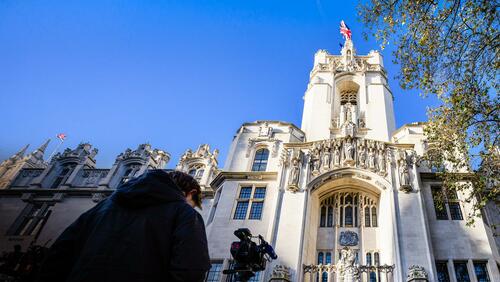 Protesters gather outside the Supreme Court in London on Nov. 15, 2023. On April 15, Britain’s highest court ruled that the words "woman" and "sex" refer to "a biological woman and biological sex" in a landmark case. Leon Neal/Getty Images
Protesters gather outside the Supreme Court in London on Nov. 15, 2023. On April 15, Britain’s highest court ruled that the words "woman" and "sex" refer to "a biological woman and biological sex" in a landmark case. Leon Neal/Getty Images
The case sought to clarify the question of whether a person who holds an official certificate recognizing their gender as female is entitled to the same women’s rights protections under the law.
A commonly cited example was the question of whether women-only services—such as a rape crisis support group—were allowed to exclude men with a gender recognition certificate.
A gender recognition certificate means that a person’s chosen gender identity is legally recognized.
Obtaining the certificate requires a medical diagnosis of gender dysphoria, having lived as the identified gender for at least two years, and the intention to live as that self-identified gender until death.
More than 8,000 gender recognition certificates have been granted in the United Kingdom since their introduction under the Gender Recognition Act of 2005.
1. How Case Was Sparked
The case was instigated by campaign group For Women Scotland in 2022, who brought a series of legal challenges, beginning in Scotland and culminating in the UK Supreme Court, over the definition of the word “woman” in the Gender Representation on Public Boards (Scotland) Act 2018.
This legislation was passed by the Scottish Parliament and mandated that 50 percent of individuals on public boards be female, including in its definition males who identify as women.
Lawyers for For Women Scotland argued that not tying the definition of sex to its “ordinary meaning” could have far-reaching consequences for sex-based rights, as well as “everyday single-sex services” such as bathrooms, changing rooms, hospital wards, and domestic violence and rape crisis centers.
Counsel for the Scottish government argued at the Supreme Court hearing in November 2024 that a person with a gender recognition certificate is “recognized in law” as having changed sex.
 Celebrations outside the Supreme Court in London on April 16, 2025. The court ruled unanimously that “the terms woman and sex in the Equality Act 2010 refer to a biological woman and biological sex.” The decision allows men who identify as women, even with a gender recognition certificate, to be excluded from single-sex spaces. Dan Kitwood/Getty Images
Celebrations outside the Supreme Court in London on April 16, 2025. The court ruled unanimously that “the terms woman and sex in the Equality Act 2010 refer to a biological woman and biological sex.” The decision allows men who identify as women, even with a gender recognition certificate, to be excluded from single-sex spaces. Dan Kitwood/Getty Images
2. The Ruling
On April 15, the Supreme Court ruled that sex is rooted in biology, not whether a person has chosen to identify as a certain gender.
Delivering the judgment, Lord Patrick Hodge, deputy president of the UK Supreme Court, said the central question is how the words “woman” and “sex” are defined in the Equality Act of 2010.
“The terms woman and sex in the Equality Act 2010 refer to a biological woman and biological sex,” Hodge said.
This means that men who identify as women and who hold a gender recognition certificate may be excluded from single-sex spaces if “proportionate.”
The judges said that while the word “biological” does not appear in the definition of man or woman in the Equality Act, “the ordinary meaning of those plain and unambiguous words corresponds with the biological characteristics that make an individual a man or a woman.”
The decision stated that if the word “sex” did not mean biological sex in the 2010 legislation, providers of single-sex spaces—including changing rooms, homeless hostels, and medical services—would face “practical difficulties” and any other interpretation would render rules against discrimination on grounds of sexual orientation meaningless.
The court said that this interpretation of the law does not disadvantage people who identify as transgender, who were described as a “potentially vulnerable group.”
They said the group is still protected from discrimination, and “would be able to invoke the provisions on direct discrimination and harassment, and indirect discrimination” if needed.
The justices also said that transgender-identifying people are protected from discrimination on the grounds of gender reassignment.
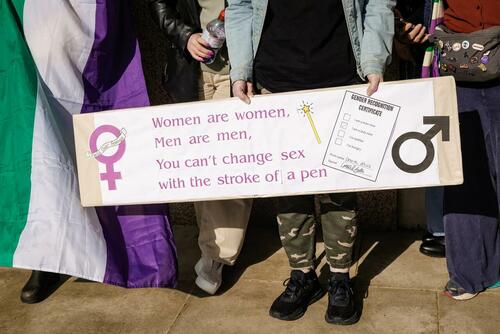 Campaigners who described themselves as women's rights activists stand next to the suffrage activist Dame Millicent Fawcett in Parliament Square in London on April 16, 2025. The Supreme Court ruled that sex is rooted in biology, not whether a person has chosen to identify as the opposite gender. Dan Kitwood/Getty Images
Campaigners who described themselves as women's rights activists stand next to the suffrage activist Dame Millicent Fawcett in Parliament Square in London on April 16, 2025. The Supreme Court ruled that sex is rooted in biology, not whether a person has chosen to identify as the opposite gender. Dan Kitwood/Getty Images
3. Lawmakers Could Overturn Court
The Supreme Court of the United Kingdom is the final court of appeal for all civil cases in the UK and of all criminal cases originating in England, Wales, and Northern Ireland.
It also covers a limited number of criminal cases from Scotland, which technically has a separate legal system.
However, a Supreme Court judgment in the UK carries a lot less weight than it would in the United States.
Lawmakers in the UK are not bound by a codified constitution that can only be changed through a super majority and other hurdles to ratification.
Rather, parliament can effectively negate a supreme court ruling by voting in new legislation.
So a simple majority vote by lawmakers is all that would be required to repeal that legislation and pass a new law that requires males who identify as women to be treated exactly the same as women.
4. Unanswered Questions
Since the decision, many public bodies and institutions have updated their rules, while others are still waiting for clarity.
The Equality and Human Rights Commission, which has responsibility for the promotion and enforcement of equality and non-discrimination laws in Britain, is expected to put an updated statutory code of practice before Parliament by the summer, and said it is working “at pace to incorporate the implications of this judgment” into the code for public bodies setting out their duties under the Equality Act.
This means that, currently, despite the Supreme Court ruling, the situation is far from clear.
5. Police Strip Searches
The British Transport Police became the first public body to take action when it changed its strip search policy a day after the judgment, saying that it had adopted a new “interim position” that will see transgender-identifying people in custody strip searched by an officer in line with their biological sex.
This means males in custody will be searched by male officers, while male officers who identify as trans women will no longer be able to search female detainees.
The National Police Chiefs’ Council has said it will be reviewing its policies, but “will need time to consider the full implications of the court’s decision, as will many other public bodies.”
Read the rest here...
-
Site: AsiaNews.itThe College of Cardinals Francis created reflects the world more than the Catholic Church, or rather, it reflects her missionary vocation. Numbers count far less than bearing evangelical witness, which Christians are expected to live in the community of nations. For this reason, starting tomorrow we will present the Who's Who of the cardinals from Asia called to enter the Sistine Chapel to elect the new pontiff.
-
Site: non veni pacem
Originally posted April 24, 2022
Trad Hate for the Divine Mercy devotion is so cringe to me. Yes, I know all about the problematic parts of St. Faustina’s diary, and there are many problems. Saints make mistakes, even to the point of sin. It happens. Sister Lucia made mistakes too. Also, it’s not the fault of St. Faustina if the Divine Mercy has overtaken devotion to the Sacred Heart, and/or diminution of the Rosary… none of that should have happened. If you are a regular reader of this space, you know of my ardent devotion to the Sacred Heart, AND His Eucharistic Heart, AND Adoration of the Blessed Sacrament, AND the Most Holy Rosary. You can have ALL of these things, if you direct your will towards them, and act.
But the subject we are dealing with today is a fact, a revealed truth, not up for debate: Divine Mercy. You are free to reject St. Faustina’s revelations completely and remain a good Catholic, as they are private revelation. But the Divine Mercy itself is not private revelation, it’s Scriptural. The administration of Divine Mercy is the very business of the Church. It’s what She was built for. It’s why you’re aboard Her. (Fans of Star Trek TOS will recognize that device)
I also think it’s totally appropriate for this feast to occur on the Octave Day of Easter. It doesn’t mean the Octave Day of Easter has been suppressed… that’s like claiming that calling it Low Sunday or Dominica in Albis or Quasimodo diminishes the Octave. Furthermore, the TLM (1962) readings for today miraculously appear to be perfect selections to instruct us on the Divine Mercy, even though the old missal obviously pre-dates the institution of the feast. Have you ever noticed that? Yes, I said miraculous. God knows what he is doing.
EPISTLE I John 5:4-10. “Beloved: For whatsoever is born of God overcometh the world. And this is the victory which overcameth the world: Our faith. Who is he that overcometh the world, but he that believeth that Jesus is the Son of God? This is he that came by water and blood, Jesus Christ: not by water only but by water and blood. And it is the Spirit which testifieth that Christ is the truth. And there are Three who give testimony in heaven, the Father, the Word, and the Holy Ghost. And these three are one. And there are three that give testimony on earth: the spirit and the water and the blood. And these three are one. If we receive the testimony of men, the testimony of God is greater. For this is the testimony of God, which is greater, because he hath testified of his Son. He that believeth in the Son of God hath the testimony of God in himself.”
How can you read that and not have the image of Divine Mercy come to mind?
Note that the Epistle and Gospel are both from St. John the Apostle.
GOSPEL John 20:19-31. “At that time, when it was late the same day, the first of the week, and the doors were shut, where the disciples were gathered together, for fear of the Jews, Jesus came and stood in the midst and said to them: “Peace be to you.” And when he had said this, he shewed them his hands and his side. The disciples therefore were glad, when they saw the Lord. He said therefore to them again: “Peace be to you. As the Father hath sent me, I also send you.” When he had said this, he breathed on them; and he said to them: “Receive ye the Holy Ghost. Whose sins you shall forgive, they are forgiven them: and whose sins you shall retain, they are retained.” Now Thomas, one of the twelve, who is called Didymus, was not with them when Jesus came. The other disciples therefore said to him: “We have seen the Lord.” But he said to them: “Except I shall see in his hands the print of the nails and put my finger into the place of the nails and put my hand into his side, I will not believe.” And after eight days, again his disciples were within, and Thomas with them. Jesus cometh, the doors being shut, and stood in the midst and said: “Peace be to you.” Then he said to Thomas: “Put in thy finger hither and see my hands. And bring hither the hand and put it into my side. And be not faithless, but believing.” Thomas answered and said to him: “My Lord and my God.” Jesus saith to him: “Because thou hast seen me, Thomas, thou hast believed: blessed are they that have not seen and have believed.” Many other signs also did Jesus in the sight of his disciples, which are not written in this book. But these are written, that you may believe that Jesus is the Christ, the Son of God: and that believing, you may have life in his name.”
So here we read, on Divine Mercy Sunday and the Octave Day of Easter, of the institution of the Sacrament of Confession. Is that not wholly appropriate? The preaching today inevitably focuses on St. Thomas, with the earlier portion of the Gospel ignored. Which is too bad, since the Sacrament of Confession is also largely ignored in the N.O. Church today, except for 3:00-3:15pm on Saturdays and by appointment only. A billion “Catholics” all over the world who think they don’t need Confession, who effectively reject it as a sacrament, wherefore rejecting the Divine Mercy. Woe to them. Christ’s offer of peace, cited twice in today’s Gospel, comes only through the Spirit, blood, and water of Divine Mercy, conferred by Grace.
Christ instructed Sister Faustina: “My daughter, tell the whole world about my inconceivable mercy. I desire that the Feast of Mercy be a refuge and shelter for all souls and especially for poor sinners. On that day, the very depths of my tender mercy are opened…the divine floodgates through which grace flows are opened. Let no soul fear to draw near to Me, even though its sins be as scarlet…Mankind will not have peace until it turns to the font of my mercy.”
“even though its sins be as scarlet…” <raises hand>
Thanks be to God for His Divine Mercy.
-
Site: Novus Motus LiturgicusWith his inquisitive right hand, Thomas searched out Thy life-bestowing side, O Christ God; for when Thou didst enter while the doors were shut, he cried out to Thee with the rest of the Apostles: Thou art my Lord and my God. (The Kontakion of St Thomas Sunday at Matins in the Byzantine Rite.)Who preserved the disciple’s hand unburnt when he drew nigh to the fiery side of the Lord? Who gave it Gregory DiPippohttp://www.blogger.com/profile/13295638279418781125noreply@blogger.com0
-
Site: Zero HedgeShare Of European Cardinals Declines Ahead Of New Pope VoteTyler Durden Sun, 04/27/2025 - 07:35
With the funeral out of the way, the conclave begins and every vote will count.
During the pontificate of the late Francis, the number of cardinals worldwide shifted somewhat away from a heavy focus on Europe. However, European cardinals continue to be overrepresented when considering the share of the world's Catholics that live on the continent. The change could have implications in the vote for the next pope, which could start in a few weeks' time.
Statista's Katharina Buchholz reports that, according to various sources collected by Pew Research Center, 41 percent of cardinals eligible to vote for a new pope upon Francis' death Monday are from Europe. This is down from 50 percent in 2013, the time of the last vote.
You will find more infographics at Statista
The pope appoints cardinals and under Francis, the number of cardinals from the Asia-Pacific region grew from 10 percent to 18 percent.
The relative share of cardinals from Sub-Saharan Africa also grew from 8 percent to 12 percent.
While the share of the world's Catholics that lives in Africa is even higher, at 19 percent, it is Latin America and the Caribbean which is the most underrepresented in terms of cardinals.
According to Vatican records, 41 percent of the world's Catholics live in the region. Under Francis, the share of Latin American and Caribbean cardinals only rose slightly, from 17 percent to 18 percent.
-
Site: PaulCraigRoberts.org
Is Trump With Us, or Is the New Boss same as the Old Boss?
“Trump is allowed to greenlight more egregiously unconstitutional assaults against our liberties than even Obama.”
“Donald Trump has commissioned uber Zionists Attorney General Pam Bondi and Secretary of Homeland Security Kristi Noem with the task of expunging the First Amendment protection of the freedom of speech for those who are vocalizing opposition to Israel’s genocide and ethnic cleansing in Gaza—or any other murderous policy emanating out of Tel Aviv, for that matter.”
-
Site: PaulCraigRoberts.org
It is White Liberals Like This One Who Are the Problem for America
They believe that they are the government, not the elected government.
-
Site: PaulCraigRoberts.org
Are Americans Still Americans?
Paul Craig Roberts
This question came to mind from reading Edward Curtin’s essays, “At the Lost and Found,” (Clarity Press, 2025), in which he shares with readers his intellectual encounters with the rising criminality of the governments of the United States since the 1960s. Edward Curtin is a decent person with a sense of justice and a moral conscience, traits more common in his time than today. I found his moral responses reassuring, and wonder if recent generations would respond in the same way.
Curtin, I suspect, was a member of the old moderate left, which was concerned with fairness and pushing a reform here and there. Today this left remains only in its elderly remnants. The modern left is not reformist. It is revolutionary, committed to using law, government, and media to overthrow traditional society and replace it with a Sodom & Gomorrah Tower of Babel in which merit is regarded as a white racist tool.
Today the left, as epitomized by the Biden regime, pushes DEI over merit, sexual perversity over love between a man and a woman, sexualization of young children, demonization of white people as racists, and ideology over truth. Today for the left the truth resides in the ideological agenda, not in facts.
Despite the digital revolution, the Internet, social media, email, and texting, the acquisition of truthful information has become ever more difficult. The reason is that for almost all parties concerned, it is the agenda that is important, not the facts. A consequence is that, unlike in the past, today we live in narratives orchestrated to serve agendas. As Curtin puts it, “we are living in a pretend society” in which truth is not present.
Curtin’s essays, like my own, vary in quality, but every decent person will enjoy escape from social media into thought about what is happening to us. I am not going to attempt to organize Curtin’s essays around a theme. I am going to limit my comments to two of his essays.
The first is about what has become of Christmas. As my readers know, for several decades it has been my habit to republish my Christmas essay, “The Greatest Gift of All,” to remind people that Christianity gave us freedom and meaning in our lives. In the Massachusetts town in which Curtin and his wife live, Christmas fireworks are a feature. As he and his wife inside their home sit holding and trying to calm the family dogs, “sentient animals with deep feelings,” who are quaking uncontrollably, Curtin thinks of “children in Gaza quivering in fear as the Israelis bomb them night and day in savage attacks” and thinks of “the visceral sense of what those Palestinians must be feeling as they hold their trembling children” who are declared by Israel’s leader to be “useless objects.”
It is America’s shame that the entire government of the United States, including President Trump, the media, and the brainwashed and indoctrinated hapless American population accept the destruction of a people, even enable it with weapons and money and deportation of persons with sufficient moral conscience to protest the genocide of a nation. Curtin has every right to raise the question, what kind of people have Americans become?
The second essay is about Curtin’s “Known Knowns,” which consists of the massive lies that the US government has based its rule upon, regardless of whether Republican or Democrat, since the 1960s. In a mere 8 pages Curtin presents the history of the US government’s degeneration into evil kept in power by lies.
He begins with the assassinations of President John F. Kennedy, Robert F. Kennedy, Malcolm X, Martin Luther King, and goes on to Allan Dulles who engineered slaughter of one million Indonesians, the orchestrated Vietnam War, the Watergate scandal orchestrated by the CIA to drive Nixon from power, the neoconservatives’ Iran-Contra scandal, the orchestrated Persian Gulf War, the Clinton regime’s bombing of four countries in four months –Afghanistan, Sudan, Iraq, and Yugoslavia, the 9/11 false flag attacks on the World Trade Center, the George W. Bush regime’s fake “war on terror,” used to strip Americans of civil liberties and to attack Afghanistan and Iraq, President Obama who institutionalized the warfare state and bombed seven countries, Trump who allowed the deadly Covid vaccine to be imposed on us and subjects the conscience of America to the support of Israel’s genocide of Palestine, and Biden who engineered the anti-Russian coup in Ukraine, renewed war with Russia, and imprisoned American citizens for exercising their constitutional rights.
From the standpoint of the American Establishment, the problem with Curtin’s indictment is that it is true.
In today’s America, to tell the truth is becoming an indication of treason for which whistleblowers, allegedly protected by federal law, are being imprisoned. This is not changing under Trump. Instead, it is expanding. If you criticize Israel, you are deported. Thus, under the Trump regime, if you speak the truth about Israel, you are considered an enemy of the state.
Americans really do need to think about how they arrived at this position. Curtin’s essays will help you.
-
Site: Zero HedgeOrbán Hits Back At Tusk's Disinformation Over Hungary Leaving The EUTyler Durden Sun, 04/27/2025 - 07:00
Authored by Thomas Brooke via Remix News,
Hungarian Prime Minister Viktor Orbán firmly denied allegations made by Polish opposition leader Donald Tusk that Hungary might leave the European Union, clarifying that his intent is to reform, not abandon, the bloc.
Orbán’s comments came in response to an X post from Tusk, who suggested Orbán was openly considering a Hungarian exit from the EU — a claim that Orbán labeled as misleading.
“Prime Minister Orbán is speaking openly today about Hungary’s exit from the European Union. It was worth winning the elections so that Kaczyński’s dream of “Budapest in Warsaw” would never come true. This is also at stake in the upcoming elections,” Tusk tweeted, referencing the famous remarks made by the leader of the Polish opposition Conservatives (PiS), Jarosław Kaczyński, after his party lost the 2011 Polish election.
Addressing Tusk directly, Orbán replied on the same platform:
“Dear Donald, don’t raise your hopes too high. Hungary will not leave the EU. We will transform it with the Patriots for Europe, to restore it to what it once was when Poland and Hungary joined.”
Dear Donald,
— Orbán Viktor (@PM_ViktorOrban) April 25, 2025
Don’t raise your hopes too high. Hungary will not leave the EU. We will transform it with the @PatriotsEU, to restore it to what it once was when Poland and Hungary joined.
Back then, Brussels bureaucrats served the people instead of themselves. Back then,… https://t.co/AmbCyl6Q9dHe emphasized that the EU at that time was focused on serving the interests of its member states, rather than interfering in their internal politics, a criticism he frequently directs at current EU officials.
Tusk’s statement was based on Orbán’s recent appearance at a public forum, where the Hungarian leader discussed ongoing tensions with Brussels but explicitly stated that exiting the EU would be irrational. “It is not reasonable to quit,” Orbán stressed, reminding the audience of his own support for Hungary’s accession in the 2003 referendum.
Orbán also shared an anecdote of former U.S. President Donald Trump repeatedly asking when Hungary would leave the EU, to which he joked in response, “Mr. President, we need a better offer.”
Orbán made clear that Hungary’s interest in EU membership extends far beyond financial benefits, pointing out the importance of a single market of 400 million consumers to Hungarian exports, 85 percent of which flow to EU member states. Instead, he advocated for substantial reforms, suggesting that his newly formed group in the European Parliament, Patriots for Europe (PfE), would eventually become influential enough to “dictate” terms for the bloc’s transformation.
Tusk’s comments drew fierce criticism from Poland’s conservative politicians. PiS MEP Arkadiusz Mularczyk accused Tusk of “scaring people” instead of engaging in meaningful discussions about the EU’s challenges. Konrad Berkowicz, vice president of the right-wing Confederation party, went further, asserting that Tusk was once again embarrassing himself by needlessly antagonizing influential leaders and countries.
The debate between Tusk and Orbán comes at a sensitive political moment in Poland, ahead of the presidential elections scheduled for May 18. Rafał Trzaskowski, mayor of Warsaw and a close ally of Tusk, is seen as the frontrunner but faces growing competition from conservative rivals Karol Nawrocki of PiS and Sławomir Mentzen from Confederation.
-
Site: southern orders
I copy this from a google search which showed an AI summary of Cardinal Dolan’s criteria for the next pope. Interesting, no?Cardinal Timothy Dolan, Archbishop of New York, has publicly expressed a desire for the next pope to embody a return to tradition and clarity in teaching. While he has not explicitly called for a specifically "traditional" pope in the sense of one adhering to pre-Vatican II practices, he has suggested that the next pontiff should offer a more refined and traditional approach to the Church's teachings and practices.Here's a more detailed look at what Dolan has suggested:- Clarity in Teaching:Dolan has emphasized the need for the next pope to offer clear and consistent teachings on the Church's doctrines.
- Refinement of Tradition:He has also called for a pope who can help to refine and preserve the Church's rich traditions.
- Emphasis on the Human Element:While not specifically mentioning traditionalism, Dolan has highlighted the importance of the next pope demonstrating a human connection with people, as Pope Francis did.
- Not Necessarily "Conservative":While Dolan is considered a conservative within the Church, he has also expressed that the next pope should reflect Pope Francis's style and be a "good shepherd".
- Not a Frontrunner:Despite his influence, Dolan is not seen as a frontrunner for the papacy.
In essence, Dolan's vision for the next pope seems to be a figure who can both offer a more traditional approach to the Church's teachings and practices while also retaining the positive aspects of Pope Francis's papacy, such as his emphasis on the human element and his ability to connect with people. -
Site: southern orders
I copy this from a google search which showed an AI summary of Cardinal Dolan’s criteria for the next pope. Interesting, no?Cardinal Timothy Dolan, Archbishop of New York, has publicly expressed a desire for the next pope to embody a return to tradition and clarity in teaching. While he has not explicitly called for a specifically "traditional" pope in the sense of one adhering to pre-Vatican II practices, he has suggested that the next pontiff should offer a more refined and traditional approach to the Church's teachings and practices.Here's a more detailed look at what Dolan has suggested:- Clarity in Teaching:Dolan has emphasized the need for the next pope to offer clear and consistent teachings on the Church's doctrines.
- Refinement of Tradition:He has also called for a pope who can help to refine and preserve the Church's rich traditions.
- Emphasis on the Human Element:While not specifically mentioning traditionalism, Dolan has highlighted the importance of the next pope demonstrating a human connection with people, as Pope Francis did.
- Not Necessarily "Conservative":While Dolan is considered a conservative within the Church, he has also expressed that the next pope should reflect Pope Francis's style and be a "good shepherd".
- Not a Frontrunner:Despite his influence, Dolan is not seen as a frontrunner for the papacy.
In essence, Dolan's vision for the next pope seems to be a figure who can both offer a more traditional approach to the Church's teachings and practices while also retaining the positive aspects of Pope Francis's papacy, such as his emphasis on the human element and his ability to connect with people. -
Site: southern orders
In recent years, the crowds for outdoor papal Masses have dwindled in number compared to other popes and even the first five years of Pope Francis. That changed in death as Pope Francis’ death and funeral, thanks be to God, saw tremendous numbers of the Faithful and curious turning out for the various rites and processions. It wasn’t anywhere near the number for St. Pope John Paul II’s funeral rites, but impressive nonetheless.
The funeral rites for Pope Francis were splendidly planned and carried out. As far as I can tell, post-Vatican II traditions for the funeral rites were followed except for the pope’s body viewed in the casket rather than outside of the coffin.
The novelty, not seen in anyone’s lifetime, was the procession from St. Peter’s to St. Mary’s. Thanks be to God for the splendid Roman day. The streets were lined with the Faithful and curious.
The only fly in the ointment for me was that the coffin was on the back of a Dodge Ram pick-up truck and not of a recent model at that! Certainly the Vatican could have done better with an actual hearse with the capability of showing the casket.
At any rate, southern rednecks loved the pickup truck but I doubt it will evangelize them and lead them to the true Church.
For the record though, I believe that both Pope Pius XII and St. Pope John XXIII died outside of the Vatican and their bodies, brought by a splendid hearse, traveled the streets of Rome to return to the Vatican and far more people lined the streets. But that was a different time in the history of the Church, pre-Vatican II, when most Catholics were Catholic and attended Mass weekly.
-
Site: Catholic Herald
On the evening of that day, the first day of the week, the doors being locked where the disciples were for fear of the Jews, Jesus came and stood among them and said to them, “Peace be with you” (John 20:19).
What was in the hearts of the eleven apostles when Jesus appeared on the evening of that first Easter Day?
Earlier, upon entering the tomb, John had come to believe that He was risen (John 20:8). Then Peter had seen Jesus one-to-one, and the rest had trusted him (Luke 24:34), but they did not believe the words of the two disciples returning from Emmaus (Mark 16:13). While these two were still speaking, Jesus appeared (Luke 24:36).
After offering them His peace, Jesus rebuked the Eleven for not trusting their two brothers who had hurried all night to Jerusalem from Emmaus (Mark 16:14).
Jesus does not only want us to believe that He is risen, but also desires us to trust others’ faith in Him. This becomes even clearer in the case of Thomas, who refused to share the others’ belief until he had experienced the Risen Jesus directly. Christ is unutterably tender with Thomas, not only recognising Thomas’s own conditions for belief, but even fulfilling them: “Put your finger here, and see my hands; and put out your hand, and place it in my side. Do not disbelieve, but believe” (John 20:27). But Jesus calls Thomas – and us – to trust Him even without seeing Him, by relying on others’ testimony: “Have you believed because you have seen me? Blessed are those who have not seen and yet have believed” (John 20:29).
Are there witnesses to Jesus’s Resurrection in my life that I do not trust? Let us accept the gentle rebuke of Jesus, as Thomas did, and rely more on the presence of Jesus in others, above all in His Church, since that is how Jesus has chosen to love us and bless us. To trust in Jesus is to trust in His Body, the Church.
Photo: “The Incredulity of Saint Thomas” by Caravaggio (public domain).

The post Trusting in the Risen Christ through the witness of others first appeared on Catholic Herald.
The post Trusting in the Risen Christ through the witness of others appeared first on Catholic Herald.
-
Site: Fr. Z's BlogYeah it’s down again and I’m working from my phone. The helicopters have recommenced their circling as heads of state get out of town. It has been a noisy couple of days. You might ask your favorite saint for technical … Read More →
-
Site: The Unz ReviewThe current Sino-US relationship is not sustainable in the long run. The US won’t give up its global hegemony. China won’t give up developing its economy and national power. US hostility is open and palpable. China is defiant and confident. There is no way to square a peg in the round role here. A Plaza...
-
Site: The Unz ReviewThe purpose of President Trump's tariff policy is not what he says it is. If the goal of the tariffs was to reindustrialize the country and create more jobs in manufacturing, the announcement would have been accompanied by an industrial policy that would outline a coordinated government effort to rebuild America's critical industries. It would...
-
Site: The Unz ReviewThis is not the comedy of the two Odessa conmen who travel across the Soviet Union trying to find a cache of jewellery hidden in twelve chairs, written in 1928. In the end, one murders the other, and then when he discovers the treasure has already been found and spent, he goes mad. This is...
-
Site: The Unz ReviewRumble link Bitchute link FFWN link Stripe is Substack’s only processor and they debanked me, so you can no longer pay me through Substack. Now I am posting everything on Substack free and asking people to sign up for recurring donations at my Paypal donation page…or better yet, the free speech platform SPdonate. Yesterday’s top...
-
Site: The Unz ReviewThis question came to mind from reading Edward Curtin’s essays, “At the Lost and Found,” (Clarity Press, 2025), in which he shares with readers his intellectual encounters with the rising criminality of the governments of the United States since the 1960s. Edward Curtin is a decent person with a sense of justice and a moral...
-
Site: The Unz ReviewWeaponizing Anti-Semitism: How the Israel Lobby Brought Down Jeremy Corbyn ASA WINSTANLEY OR Books, 2023 Jeremy Corbyn was the leader of Britain’s Labour Party prior to the current Prime Minister, Keir Starmer, taking over in 2015 remaining leader until Labour’s comprehensive defeat in 2019. Despite losing the snap General Election in 2017, Labour exceeded expectations...
-
Site: Zero HedgeEscobar: China, Hong Kong, & The Art Of BlinkingTyler Durden Sat, 04/26/2025 - 23:20
Authored by Pepe Escobar,
So, predictably, Captain Chaos did blink first. As much as he – and his sprawling media circus – could not possibly admit it.
It all started with “tariff exemptions” – from smartphones and computers to auto parts – on products imported from China. Then it veered towards carefully manicured leaks implying tariffs “could” be reduced to a range between 50% and 65%. And finally a terse admission that if there’s no deal, a “tariff number” will be unilaterally set.
China’s Ministry of Commerce was unforgiving: “Trying to trade away others’ interests for temporary gains is like bargaining with a tiger for its skin – it will only backfire”.
And it got fiercer. The Ministry was adamant that any Trump 2.0 claims of any progress on bilateral negotiations have “no factual basis” – de facto depicting the US President as a purveyor of fake news.
Tigers, tigers burning bright: the image does not recall poetry superstar William Blake, but Mao’s legendary depiction of the US Empire as a “paper tiger” – a flashback that struck me over and over again last week in Shanghai. If the US Empire was a paper tiger already in the 1960s, the Chinese argue, imagine now.
And the pain will increase, not only for the paper tiger: any dodgy deals made by foreign – vassal – pussycat governments at the expense of Chinese interests simply will be not be tolerated by Beijing.
Last week in Shanghai I was reminded over and over again – by academics and business people – that the weaponized Trump Tariff Tizzy (TTT) goes way beyond China: it is a desperate offense ordered by the US ruling classes against a peer competitor that scares the hell out of them.
The best Chinese analytical minds know exactly what’s going on in Washington. Take for instance this essay originally published by the influential Cultural Horizon magazine breaking down the “triangular power structure” of Trump 2.0.
We have all-power Trump forming a “super-establishment”; Silicon Valley money politics, represented by Elon Musk; and the new right-wing elite represented by VP J.D. Vance. End result: a “governance system that is almost parallel to the federal government.”
European chihuahuas – caught in the crossfire of Trump 2.0 – are simply incapable of such synthetic and precise conceptualization.
Paper tiger meets fiery dragon
What a deep dive in Shanghai has revealed is that China has been handed over a rare earth-like opportunity by Trump 2.0 to consolidate its strategic initiative solidifying the role of leader of the Global South/Global Majority, at the same time carefully managing the risk of a New Cold War.
Call it a Sun Tzu move that may paralyze the Empire in its tracks. Professor Zhang Weiwei, with whom I had the pleasure to share a seminar in Shanghai on the Russia-China strategic partnership, would agree.
China is on the move across the spectrum. Chinese Premier Li Qiang sent a letter to Japanese Prime Minister Shigeru Ishibe urging a joint drive, right now, to counteract the tariff dementia.
President Xi’s top message in his Southeast Asia tour last week was to stand up against “unilateral bullying”.
Xi deftly moved between Malaysia – current rotating chair of ASEAN, always avoiding taking sides – and Vietnam – with its “bamboo diplomacy” always hedging between US and China.
Xi told Malaysia’s Prime Minister Anwar Ibrahim, directly: “We must safeguard the bright prospects of our Asian family”. Translation: let’s create an exclusive sphere of influence close to the ‘community of shared destiny’ but that does not include outside powers such as the US.
In parallel, there has been a strong debate – from Shanghai to Hong Kong – that transcends the role of China as the world’s factory: what matters now is how to redirect some of China’s astonishing manufacturing capacity towards the domestic market.
Of course there are problems – such as the lack of purchasing power among scores of Chinese domestic consumers, even as the bulk of national China income is directed to fixed-asset investments. A great deal of China’s rural elderly population survives on a monthly pension of roughly $30 a month, and the hourly rate for the gig economy has stagnated at around $4.
Meanwhile, in several high-tech fronts, China just built the fastest high-speed train on the planet: 400km/h, soon to run between Beijing and Shanghai. China is already receiving orders for the C919 commercial wide-bodied airliner. And China has come up with the world’s first thorium-powered nuclear reactor. Translation: unlimited cheap and clean energy is at hand.
The Mafia way of doing business
Hong Kong is a very special case. HSBC executives, for instance, worry about a possible decoupling between US and China – and wonder whether Hong Kong may survive without US trade.
Yes, it can. The US is Hong Kong’s third largest trade partner; yet Hong Kong’s export and import to the US are only 6,5% and 4%, respectively, of its total global exports and imports, including transshipment of goods back and forth from the mainland.
HK is a world-class logistics hub and free port. So as long as Trump 2.0 does not forbid trade with Hong Kong – well, anything can happen – imports should not be affected. Anyway, most of what HK exports – electronics, luxury goods, clothes, toys – can easily find alternative markets in Southeast Asia, West Asia and Europe.
The crucial point is that over half of Hong Kong trade is with the mainland. And the key fact is that China can easily survive without US trade. Beijing has been carefully preparing for it since Trump 1.0.
From Shanghai to Hong Kong, the best analytical minds are in tune with the inestimable Michael Hudson, who has emphasized, over and over again, how “the United States is the only country in the world that has weaponized its foreign trade; weaponized its foreign currency, the dollar; weaponized the international financial system; and treated every economic relationship in an adversarial way, to weaponize it.”
A self-confident, high-tech savvy China, from academics and business people to xiao long bao and pulled noodles vendors, graphically understands that the Empire of Chaos, in its drive to “isolate” China, is only isolating itself (and its chihuahuas).
Moreover it’s such a joy to see Michael Hudson also referring to the same “paper tiger” syndrome that I witnessed in Shanghai these past few days: “Well, America has become a paper tiger financially today. It doesn’t really have anything to offer except the threat of tariffs, the threat of suddenly disrupting all of the trade patterns that have been put in place over the last few decades.”
In Shanghai, I heard serial implacable dismissals of the so-called “Miran plan” – as in the paper published last November by Trump’s economic advisor “restructuring the global trading system”. Miran is the brain behind the Mar-a-Lago accord – whose rationale is to weaken the US dollar by forcing major economies – from China to Japan and the EU – to sell US dollar assets and swap short-term US Treasuries for 100-year bonds with zero interest.
Miran’s brilliant idea boils down to nations having only two options:
1.Meekly accept these US tariffs, without retaliation.
2. Write cheques to the US Treasury.
Zhao Xijun, co-dean of the China Capital Market Research Institute at Renmin University, destroyed the scheme succinctly: transferring money to the US Treasury like this is like “collecting protection money on the streets”. Translation: that’s the Mafia way, “a thuggish and domineering act, merely dressed up with the lofty justification of providing public goods”.
Meanwhile, in the Grand Chessboard, Beijing keeps working steadily side by side with Russia towards a Eurasian-wide security architecture anchored on a balance of powers: it’s all about the new Primakov triangle (RIC – Russia, Iran and China).
Top BRICS members Russia and China will not allow the Empire to attack fellow BRICS member Iran. And support comes in more ways than one. Example: more imperial energy sanctions on Iran? China will increase imports via Malaysia, and invest even more in Iran’s infrastructure, in tandem with Russia in respect to the International North South Transportation Corridor (INSTC).
In a nutshell: Captain Chaos definitely does not have the cards – which as even South Pacific penguins know, are all made in China.
* * *
Views expressed in this article are opinions of the author and do not necessarily reflect the views of ZeroHedge.
-
Site: Novus Ordo Watch
“The death of the wicked is very evil…” (Psalm 33:22)
Bergoglio’s Burial:
The Funeral and Interment of ‘Pope’ Francis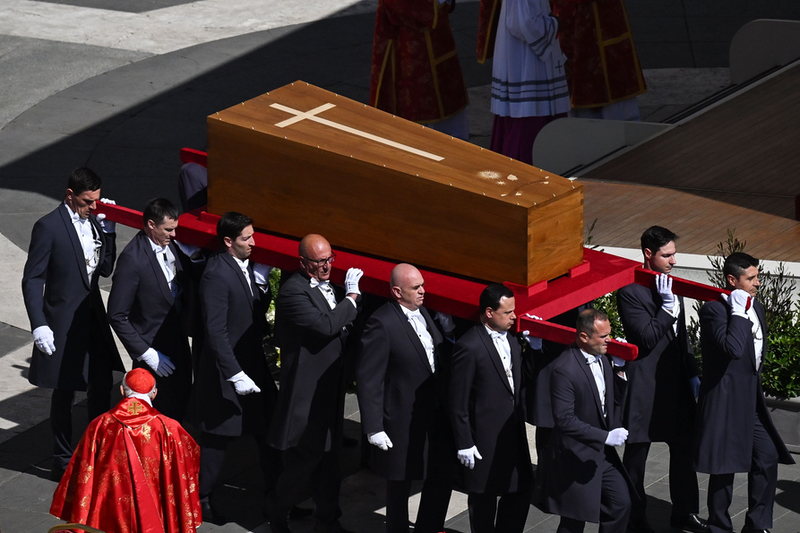 (image credit: James Veysey/Shutterstock)
(image credit: James Veysey/Shutterstock)The funeral of the man known as ‘Pope Francis’, the Jesuit apostate Jorge Mario Bergoglio, took place in St. Peter’s Square of Vatican City on Saturday, April 26, 2025. The main celebrant was ‘Cardinal’ Giovanni Battista Re, Dean of the College of [Novus Ordo] Cardinals.
Bergoglio’s obsequies and interment took place five days after his death on Apr. 21.
Official Vatican Information and News Coverage
… READ MORE -
Site: Novus Ordo Wire – Novus Ordo Watch
“The death of the wicked is very evil…” (Psalm 33:22)
Bergoglio’s Burial:
The Funeral and Interment of ‘Pope’ Francis (image credit: James Veysey/Shutterstock)
(image credit: James Veysey/Shutterstock)The funeral of the man known as ‘Pope Francis’, the Jesuit apostate Jorge Mario Bergoglio, took place in St. Peter’s Square of Vatican City on Saturday, April 26, 2025. The main celebrant was ‘Cardinal’ Giovanni Battista Re, Dean of the College of [Novus Ordo] Cardinals.
Bergoglio’s obsequies and interment took place five days after his death on Apr. 21.
Official Vatican Information and News Coverage
… READ MORE -
Site: RT - News
Donald Tusk has pledged to build the region’s most powerful military force under a new national doctrine
Polish Prime Minister Donald Tusk has announced a new national doctrine that seeks to turn Warsaw into an “economic miracle” protected by the “strongest army in the region,” in a speech marking the 1,000th anniversary of the creation of the Kingdom of Poland.
Speaking on Friday in Gniezno, the city where the first King of Poland, Boleslaw the Brave, was crowned a millennium ago, Tusk outlined the three “pillars” of the National Piast Doctrine, named after the country's first historical ruling house.
“We will have the strongest army in the region. Don’t say it’s impossible. Yes, our army must be able to overcome any threat. From the east, west, south – it doesn’t matter,” Tusk said of the first pillar in his address. He promised to “take advantage of this tragic, dramatic experience of this war that is going on beyond our borders.”
The second pillar of the doctrine is to build “the strongest economy in the region.”
Read more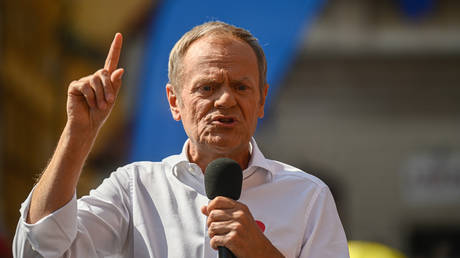 Poland intends to profit from Ukraine aid – Tusk
Poland intends to profit from Ukraine aid – Tusk
“Poland is strengthening its position among the absolute leaders of economic growth in Europe,” Tusk said. “Today we are really one step away from the fact that not only in Europe but all over the world people will say with admiration: ‘Oh, Poland, this is an economic miracle.’”
Political influence in the EU and globally forms the third pillar of the doctrine, Tusk said, stressing the importance of maintaining strong ties with Warsaw’s “most important ally,” Washington.
Polish President Andrzej Duda reportedly even urged Washington to move part of its nuclear arsenal stored in Western Europe or the United States to Poland. US Vice President J.D. Vance said he would be “shocked” if President Donald Trump ever supported such an idea.
Read more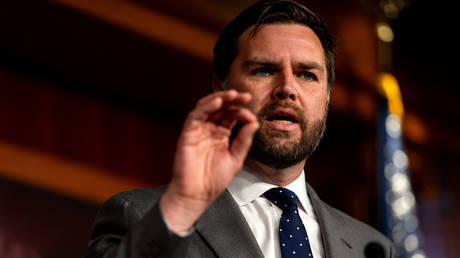 Vance assesses Poland’s nuke request
Vance assesses Poland’s nuke request
Poland has been among Ukraine’s main supporters since the escalation of the conflict with Russia in 2022, providing more than €5.1 billion ($5.7 billion) in aid, over 70% of which was military, according to Germany’s Kiel Institute. The country has also taken in a large number of refugees from its neighbor, although public attitudes have reportedly cooled amid the influx of arrivals.
Warsaw will ”brutally” protect its economic interests and intends to profit from future aid to Ukraine, including from post-conflict reconstruction, Tusk said earlier this month.
Polish officials have increasingly called for militarization to address the alleged threat posed by Russia. Moscow has rejected these claims, stating that NATO and EU leaders are merely “fearmongering” in order to push their populations into supporting such measures.
-
Site: The Remnant Newspaper - Remnant ArticlesIn this episode of The Underground, Michael J. Matt covers the death of Pope Francis and what the world might expect from his successor. The question is—will it be Pius XIII, or Francis II? Plus, some good news – on the same day that Francis died, the World Economic Forum announced its investigation into corruption charges against Klaus Schwab. Yep, DEI is DOA! But wait, there’s more! Last week, President Donald Trump quietly waved off Bibi Netanyahu’s insane missile attack on Iran that could well have sparked World War III. Bye-bye, Bibi. Who said resistance is futile! Michael breaks down…
-
Site: Zero HedgeThe Next Phase Of Surveillance? Getting Under Your SkinTyler Durden Sat, 04/26/2025 - 22:10
Authored by Aaron Kheriarty via The Brownstone Institute,
Here’s the video link to my recent talk at Hillsdale College on AI and Transhumanism. I’m including below the text of the speech if you prefer to read rather than watch it.
AI and Transhumanism
Hackable Animals
My friends, let me introduce you to Yuval Noah Harari, a man chock full of big ideas. He explained during the covid crisis: “Covid is critical because this is what convinces people to accept, to legitimize, total biometric surveillance. If we want to stop this epidemic, we need not just to monitor people, we need to monitor what’s happening under their skin.” In a 60 Minutes interview with Anderson Cooper, Harari repeated this idea: “What we have seen so far is corporations and governments collecting data about where we go, who we meet, what movies we watch. The next phase is the surveillance going under our skin.” He likewise told India Today, when commenting on changes accepted by the population during covid:
We now see mass surveillance systems established even in democratic countries which previously rejected them, and we also see a change in the nature of surveillance. Previously, surveillance was mainly above the skin; now we want it under the skin… Governments want to know not just where we go or who we meet. They want to know what’s happening under our skin: what is our body temperature; what is our blood pressure; what is our medical condition?
Harari is clearly a man who wants to… get under your skin. He just might succeed. Another recent interview finds him waxing philosophical: “Now humans are developing even bigger powers than ever before. We are really acquiring divine powers of creation and destruction. We are really upgrading humans into gods. We are acquiring, for instance, the power to re-engineer human life.” As Kierkegaard once said of Hegel when he talks about the Absolute, when Harari talks about the future, he sounds like he’s going up in a balloon.
Forgive me, but a few last nuggets from Professor Harari will round out the picture of his philosophy, and his lofty hopes and dreams: “Humans are now hackable animals. You know, the whole idea that humans have this soul or spirit, and they have free will and nobody knows what’s happening inside me, so, whatever I choose, whether in the election or in the supermarket, that’s my free will—that’s over.” Harari explains that to hack human beings you need a lot of computing power and a lot of biometric data, which was not possible until recently with the advent of AI. In a hundred years, he argues, people will look back and identify the Covid crisis as the moment “when a new regime of surveillance took over, especially surveillance under the skin—which I think is the most important development of the 21st Century, which is this ability to hack human beings.”
People rightly worry that their iPhone or Alexa have become surveillance “listening devices”, and indeed, the microphone can be turned on even when the device is turned off. But imagine a wearable or implantable device that, moment-to-moment, tracks your heart rate, blood pressure, and skin conductance, uploading that biometric information to the cloud. Anyone with access to that data could know your exact emotional response to every statement made while you watch a presidential debate. They could gauge your thoughts and feelings about each candidate, about each issue discussed, even if you never spoke a word.
I could go on with more quotes from Professor Harari about hacking the human body, but you get the picture. At this point you may be tempted to dismiss Harari as nothing more than an overheated, sci-fi obsessed village atheist. After years binging on science fiction novels, the balloon of his imagination now perpetually floats up somewhere above the ether. Why should we pay any heed to this man’s prognostications and prophesies?
It turns out that Harari is a professor of History at the Hebrew University of Jerusalem. His bestselling books have sold over 20 million copies worldwide, which is no small shake. More importantly, he is one of the darlings of the World Economic Forum and a key architect of their agenda. In 2018, his lecture at the WEF, “Will the Future Be Human?” was sandwiched between addresses from German Chancellor Angela Merkel and French President Emmanuel Macron. So he’s playing in the sandbox with the big dogs.
In his WEF lecture Harari explained that in the coming generations, we will “learn how to engineer bodies and brains and minds,” such that these will become “the main products of the 21st Century economy: not textiles and vehicles and weapons, but bodies and brains and minds.” The few masters of the economy, he explains, will be the people who own and control data: “Today, data is the most important asset in the world,” in contrast to ancient times when land was the most important asset, or the industrial age when machines were paramount. WEF kingpin Klaus Schwab echoed Harari’s ideas when he explained: “One of the features of the Fourth Industrial Revolution is that it doesn’t change what we are doing; it changes us,” through gene editing and other biotechnological tools that operate under our skin.
Even the dreamy-eyed Harari admits there are some potential dangers with these developments: “If too much data is concentrated in too few hands, humanity will split not into classes but into two different species.” That would not, one supposes, be a good thing. But all things considered, he is more than willing to take these risks and forge ahead with this agenda. To be fair, Harari does not advocate for a future totalitarian state or rule by all-powerful corporations, but hopes to warn us of coming dangers.
In an exceptionally naïve proposal, however, Harari believes that the obvious problems posed by a tyrannical biosecurity state can be solved with more surveillance, by having citizens simply surveil the government: “Turn it around,” he said in a talk at the Athens Democracy Forum, “Surveil the governments more. I mean, technology can always go both ways. If they can surveil us, we can surveil them.” This proposal is—not to put too fine a point on it—incredibly stupid. As most of us learned in kindergarten, two wrongs don’t make a right.
The WEF made waves a few years back by posting on their website the slogan, “You will own nothing. And you will be happy.” Although the page was later deleted, the indelible impression remained: it provided a clear and simple description of the future envisioned by Davos Man. As the WEF savants predict, at the last stage of this development, we will find ourselves in a rent-only/subscription-only economy, where nothing really belongs to us. Picture the Uberization of everything.
To get a sense of this future, imagine the world as an Amazon warehouse writ large: a mandarin caste of digital virtuosos will call the shots from behind screens, directing the masses below with the aid of ever more refined algorithmic specificity. The prophetic Aldous Huxley foresaw this Brave New World in his 1932 novel. These changes will challenge not only our political, economic, and medical institutions and structures; they will challenge our notions of what it means to be human. This is precisely what its advocates celebrate, as we will see in a moment.
Corporatist arrangements of public-private partnerships, which merge state and corporate power, are well suited for carrying out the necessary convergence of existing and emerging fields. This biological-digital convergence envisioned by the WEF and its members will blend big data, artificial intelligence, machine learning, genetics, nanotechnology, and robotics. Schwab refers to this as the Fourth Industrial Revolution, which will follow and build upon the first three—mechanical, electrical, and digital. The transhumanists—who we will meet in a moment—have been dreaming of just such a merging of the physical, digital, and biological worlds for at least a few decades. Now, however, their visions are poised to become our reality.
Mechanisms of Control
The next steps in hacking human beings will involve attempted rollouts—which we should vigorously resist—of digital IDs, tied to fingerprints and other biometric data like iris scans or face IDs, demographic information, medical records, data on education, travel, financial transactions, and bank accounts. These will be combined with Central Bank Digital Currencies, giving governments surveillance power and control over every one of your financial transactions, with the ability to lock you out of the market if you do not comply with government directives.
Using biometrics for everyday transactions routinizes these technologies. We are conditioning children to accept biometric verification as a matter of course. For example, face IDs are now used in multiple school districts to expedite the movement of students through school lunch lines. Until recently, biometrics such as fingerprints were used only for high-security purposes—when charging someone with a crime, for example, or when notarizing an important document. Today, routine biometric verification for repetitive activities from mobile phones to lunch lines gets young people used to the idea that their bodies are tools used in transactions. We are instrumentalizing the body in unconscious and subtle, but nonetheless powerful, ways.
Those with economic interests in creating markets for their products (whether vaccines, digital surveillance hardware and software, or harvested data) will continue to deploy the carrots and sticks of access to medical care and other services to strongarm acceptance of digital IDs in underdeveloped nations. In developed nations they will initially use a velvet glove approach of nudges, selling digital IDs as convenience and time-saving measures that will be hard for many to turn down, like skipping long TSA security lines at airports. The privacy risks, including the possibility for constant surveillance and data harvesting, will fade into the background when you’re about to miss your flight if you can’t skip to the front of the line.
Unless we collectively decline to participate in this new social experiment, digital IDs—tied to private demographic, financial, location, movement, and biometric data—will become mechanisms for bulk data harvesting and tracking of populations around the globe. We should resist—including by opting out of the new face ID scans at TSA airport screening checkpoints, which we can still legally do.
Once fully realized, this surveillance system will offer unprecedented mechanisms of control, allowing the regime to be maintained against any form of resistance. This technocratic dream would entrench the most intransigent authoritarian system the world has ever known—in the sense that it could maintain itself against any form of opposition through monopolistic technological and economic power. The suppression of dissent will happen in large part through the system’s financial controls, especially if we adopt Central Bank Digital Currencies. Try to resist or step outside the system’s strictures and the doors to markets will simply close. This means that once this system is in place, it could prove almost impossible to overthrow.
Microwaved Eugenics
Harari—who I cited extensively at the beginning of this talk—is among the more prominent members of a new species of academics, activists, and “visionaries” that refer to themselves as transhumanists. These folks aim to use technology not to alter the lived environment, but to fundamentally alter human nature itself. The goal is to “upgrade” or “enhance” human beings. This is both possible and desirable, as Harari explains, because all organisms—whether humans or amoebas or bananas or viruses—are at bottom just “biological algorithms.” This is the old materialist, social Darwinist ideology turbocharged and techno-upgraded with the tools of gene editing, nanotechnology, robotics, and advanced pharmaceuticals. Transhumanism is microwaved eugenics. There is nothing new under the sun.
The 20th-century eugenicists referred to disabled persons as “useless eaters.” Echoing this rhetoric on multiple occasions, Harari has puzzled over the question of what to do with people in the future who will refuse AI-mediated enhancement—folks he refers to as “useless people.” “The biggest question maybe in economics and politics in the coming decades,” he predicts, “will be what to do with all these useless people?” He goes on to explain, “The problem is more boredom, what to do with them and how will they find some sense of meaning in life when they are basically meaningless, worthless.”
Harari suggests one possible solution to the problem of what to do with useless people: “My best guess at present is a combination of drugs and computer games.” Well, at least we have a head start on that, a fact that does not escape Harari’s attention: “You see more and more people spending more and more time, or solving their time with drugs and computer games, both legal drugs and illegal drugs,” he explains. This is where Harari predicts those who refuse to be hacked for AI-enhancement purposes will find themselves.
Encountering Harari’s thought was not my first brush with the transhumanist movement. Several years ago, I spoke on a panel at Stanford University sponsored by the Zephyr Institute on the topic of transhumanism. I critiqued the idea of “human enhancement,” the use of biomedical technology not to heal the sick but to make the healthy “better than well,” i.e., bigger, faster, stronger, smarter, etc. The event was well attended by several students from the Transhumanist Club at Stanford.
We had a cordial discussion, and I enjoyed chatting with these students after the talk. I learned the symbol of their student group was H+ (“humanity-plus”). They were exceptionally bright, ambitious, and serious young men and women—typical Stanford students. Some of them had read their Plato in addition to their Scientific American. They sincerely wanted to make the world better. Perhaps there was a closet authoritarian or two among them, but my impression was that they had no interest in facilitating world domination by oligarchic corporatist regimes empowered to hack human beings.
Nevertheless, I got the impression that they did not comprehend the implications of the axioms they had accepted. We can choose our first principles, our foundational premises, but then we must follow them out to their logical conclusions; otherwise, we deceive ourselves. These Stanford students were not outliers, but representative of the local culture: transhumanism is enormously influential in Silicon Valley and shapes the imagination of many of the most influential tech elites. Proponents include the Oxford University philosopher Nick Bostrom, Harvard geneticist George Church, the late physicist Stephen Hawking, Google engineer Ray Kurzweil, and other notables.
The Transhumanist Dream
Returning to Harari’s 2018 talk at the WEF, he admits that control of data might not only enable human elites to build digital dictatorships, but opines that hacking humans may facilitate something even more radical: “Elites may gain the power to re-engineer the future of life itself.” With his Davos audience warmed up he then waxes to a crescendo: “This will not just be the greatest revolution in the history of humanity, it will be the greatest revolution in biology since the beginning of life four billion years ago.”
Which is, of course, a pretty big deal. Because for billions of years, nothing fundamental changed in the basic rules of the game of life, as he explains: “All of life for four billion years—dinosaurs, amoebas, tomatoes, humans—all of life was subject to the laws of natural selection and to the laws of organic biochemistry.” But not anymore: all this is about to change, as he explains:
Science is replacing evolution by natural selection with evolution by intelligent design—not the intelligent design of some god above the cloud, but our intelligent design, and the design of our clouds: the IBM cloud, the Microsoft cloud—these are the new driving forces of evolution. At the same time, science may enable life—after being confined for four billion years to the limited realm of organic compounds—science may enable life to break out into the inorganic realm.
The opening sentence here perfectly echoes the original definition of eugenics from the man who coined the term in the late 19th Century, Sir Francis Galton, Charles Darwin’s cousin: “What nature does blindly, slowly, and ruthlessly [evolution by natural selection], man may do providently, quickly, and kindly [evolution by our own—or by the cloud’s—intelligent design].” But what is Harari talking about in that last sentence—life breaking out into the inorganic realm?
It’s been a transhumanist dream from the dawn of modern computing that someday we will be able to upload the informational content of our brains, or our minds (if you believe in minds), into some sort of massive computing system, or digital cloud, or other technological repository capable of storing massive amounts of data. On this materialist view of man, we will then have no more need for our human body, which, after all, always fails us in the end. Shedding this mortal coil—this organic dust that always returns to dust—we will find the technological means to… well, to live forever. Living forever in the digital cloud or the mainframe computer in the sky constitutes the transhumanists’ eschatology: salvation by digital technology.
This project is physically (and metaphysically) impossible, of course, because man is an inextricable unity of body and soul—not some ghost in the machine, not merely a bit of software transferable to another piece of hardware. But set that aside for now; look instead at what this eschatological dream tells us about the transhumanist movement. These imaginative flights of fancy have obviously moved well beyond the realm of science. Transhumanism is clearly a religion—indeed, a particular type of neo-Gnostic religion. It attracts adherents today—including educated, wealthy, powerful, culturally influential adherents—because it taps into unfulfilled, deeply religious aspirations and longings. It is an ersatz substitute religion for a secular age.
That Hideous Strength
I cannot emphasize enough the importance for our time of C.S. Lewis’s book, The Abolition of Man. Lewis once remarked that his dystopian novel, That Hideous Strength, the third installment in his “space trilogy,” was The Abolition of Man in fictional form. Those who have learned from Huxley’s Brave New World and Orwell’s Nineteen Eighty-Four would do well to also read That Hideous Strength, an underappreciated entry in the dystopian fiction genre. Back in 1945, Lewis foresaw Yuval Harari and his transhumanist ilk on the horizon. He brilliantly satirized their ideology in the novel’s character of Filostrato, an earnest but deeply misguided Italian scientist.
In the story, a cabal of technocrats take over a bucolic university town in England—think of Oxford or Cambridge—and go to work immediately transforming things according to their vision of the future. The novel’s protagonist, Mark Studdock, is recruited away from the university to the technocrats’ new institute. Mark desires above all to be part of the progressive set, the “inner ring” that is steering the next big thing. He spends his first several days at the N.I.C.E (National Institute for Coordinated Experiments) trying in vain to ascertain exactly what his new job description entails.
Eventually, he figures out that he has been retained mainly to write propaganda explaining the Institute’s activities to the public. Somewhat dispirited—he is a scholar of the social sciences, after all, and not a journalist—he sits down at lunch one day with Filostrato, a member of the N.I.C.E. inner circle, and learns a bit about this scientist’s worldview.
It happens that Filostrato has just given orders to cut down some beech trees on the Institute’s property and replace them with trees made of aluminum. Someone at the table naturally asks why, remarking that he rather liked the beech trees. “Oh, yes, yes,” replies Filostrato. “The pretty trees, the garden trees. But not the savages. I put the rose in my garden, but not the brier. The forest tree is a weed.” Filostrato explains that he once saw a metal tree in Persia, “so natural it would deceive,” which he believes could be perfected. His interlocutor objects that a tree made of metal would hardly be the same as a real tree. But the scientist is undeterred and explains why the artificial tree is superior:
“But consider the advantages! You get tired of him in one place: two workmen carry him somewhere else: wherever you please. It never dies. No leaves to fall, no twigs, no birds building nests, no muck and mess.”
“I suppose one or two, as curiosities, might be rather amusing.”
“Why one or two? At present, I allow, we must have forests, for the atmosphere. Presently we find a chemical substitute. And then, why any natural trees? I foresee nothing but the art tree all over the earth. In fact, we clean the planet.”When asked if he means that there would be no vegetation at all, Filostrato replies, “Exactly. You shave your face: even, in the English fashion, you shave him every day. One day we shave the planet.” Someone wonders what the birds will make of it, but Filostrato has a plan for them too: “I would not have any birds either. On the art tree I would have the art birds all singing when you press a switch inside the house. When you are tired of the singing you switch them off. Consider again the improvement. No feathers dropped about, no nests, no eggs, no dirt.”
Mark replies that this sounds like abolishing pretty much all organic life. “And why not?” Filostrato counters. “It is simple hygiene.” And then, echoing the rhetoric of Yuval Harari, we hear Filostrato’s soaring peroration, which would have been right at home in World Economic Forum’s annual meeting in Davos:
“Listen, my friends. If you pick up some rotten thing and find this organic life crawling over it, do you not say, ‘Oh, the horrid thing. It is alive,’ and then drop it?… And you, especially you English, are you not hostile to any organic life except your own on your own body? Rather than permit it you have invented the daily bath…. And what do you call dirty dirt? Is it not precisely the organic? Minerals are clean dirt. But the real filth is what comes from organisms—sweat, spittles, excretions. Is not your whole idea of purity one huge example? The impure and the organic are interchangeable conceptions…. After all, we are organisms ourselves.
“I grant it… In us organic life has produced Mind. It has done its work. After that, we want no more of it. We do not want the world any longer furred over with organic life, like what you call the blue mold—all sprouting and budding and breeding and decaying. We must get rid of it. By little and little, of course. Slowly we learn how. Learn to make our brains live with less and less body: learn to build our bodies directly with chemicals, no longer have to stuff them full of dead brutes and weeds. Learn how to reproduce ourselves without copulation.”
Someone interjects that this last part does not sound like much fun, but Filostrato responds, “My friend, you have already separated the Fun, as you call it, from fertility. The Fun itself begins to pass away…. Nature herself begins to throw away the anachronism. When she has thrown it away, then real civilization becomes possible.” Keep in mind that this was written decades before the invention of in vitro fertilization and other assisted reproductive technologies, as well as the sexual revolution that brought widespread acceptance of the oral contraceptive pill. As Lewis reveals at the end of the novel, however, the N.I.C.E is not controlled by brilliant men of science but is ultimately under the sway of demonic forces.
In both the real character of Harari and the fictional character of Filostrato we find men who embrace, indeed celebrate, the idea that human beings can shed the messy business of organic life and somehow transfer our bodily existence into sterile inorganic matter. We encounter in both characters the kind of man who wants to bleach the entire earth with hand sanitizer. Were we not nudged, perhaps a bit too far, in the direction of Filostrato’s dream during covid, as we attempted to fully disinfect and sanitize our lived environments, and transfer all our communications to the digital realm? Have we not also moved in this direction by spending more waking hours glued to screens in a virtual world than interacting with people in the real world, while reams of behavioral data are extracted from our every keystroke and click for predictive analysis by AI?
Organic matter is alive, whereas inorganic matter is dead. I can only conclude that the transhumanists’ dream is, in the last analysis, a philosophy of death. But we must grant that it has become an influential philosophy among many of today’s elites. In one way or another, all of us have been seduced by the mistaken notion that by massively coordinated vigilance and the application of technology, we could rid our lived environments of pathogens and scrub our world entirely clean—perhaps even thwarting death.
As the Italian philosopher Augusto Del Noce pointed out, philosophies that begin from faulty premises not only fail to achieve their purpose, they inevitably end up producing the exact opposite of their stated goals. Transhumanism aims at superior intelligence, superhuman strength, and unending life.
But because it is grounded in an entirely false notion of what it means to be human, if we recklessly embrace the transhumanist dream, we will find ourselves instead in a nightmare dystopia of stupidity, weakness, and death.
-
Site: Zero Hedge"iPhone Moment" Nears For Humanoid RobotsTyler Durden Sat, 04/26/2025 - 21:35
Brett Adcock, founder of Archer Aviation, who left the flying taxi company to pursue humanoid robotics and the deployment of Artificial General Intelligence, recently shared how his team at Figure AI developed a humanoid robot in just 31 months, achieving the robot's first successful walk within a year.
Adcock recently spoke at the 2025 Abundance360 summit in Los Angeles and described how humanoid robots are the ultimate "deployment vector" for AGI, comparing what's happening in robotics to an "iPhone moment"- a game-changing breakthrough when a new product suddenly transforms an industry.
Adcock said that Figure AI designs a new hardware platform every 12 to 18 months. He noted that his startup has secured commercial customers like BMW...
BMW x Figure Update
— Figure (@Figure_robot) March 31, 2025
This isn't a test environment—it's real production operations
Real-world robots are advancing our Helix AI and strengthening our end-to-end autonomy to deploy millions of robots pic.twitter.com/p8a7OD7r3UHe forecasts that Figure AI's humanoid robots will be affordable, around $20,000 to $30,000, allowing for widespread adoption in both the workplace and the home.
Meet Helix, our in-house AI that reasons like a human
— Figure (@Figure_robot) February 20, 2025
Robotics won't get to the home without a step change in capabilities
Our robots can now handle virtually any household item: pic.twitter.com/Wsx5s8QelcHere's a summary of Adock's conversation about humanoid robotics and how the industry is in the midst of an "iPhone moment":
-
(00:00–01:42): Brett Adcock, founder of Figure, rapidly launched humanoid robots from scratch in 31 months. He sees humanoid robots as the ultimate "deployment vector" for AGI (Artificial General Intelligence), comparable to an "iPhone moment" happening now.
-
(02:21–03:30): Adcock stresses that giving AGI a physical body is critical to avoid dystopian outcomes where powerful AI remains trapped in servers. Humanoids allow AGI to learn and act through transfer learning and multitasking.
-
(06:24–07:54): Commercial robots are already operating at BMW's largest US plant (Spartanburg, SC), autonomously performing repetitive manufacturing tasks. Demand is growing, with a second logistics customer signed.
-
(08:28–09:58): Long-term goal: humanoid robots for home use, priced around $20,000–$30,000, leasing for about $300/month. At that rate, Adcock envisions multiple robots per home doing chores like dishwashing, laundry, dog-walking.
-
(10:40–12:28): Figure's success is attributed to assembling a world-class, hardworking team with a laser-focused, high-intensity culture (working 5–7 days a week in person) and a shared "ship-product" mindset.
-
(14:30–15:43): To succeed, Figure had to solve three hard problems: build ultra-reliable humanoid hardware, teach humanoids through neural nets (not hand-coded controls), and generalize actions to unfamiliar tasks via language instructions.
-
(16:51–19:17): Figure abandoned external AI vendors like OpenAI and built its own large vision-language-action AI model called Helix. Robots using Helix can generalize and complete new tasks, like putting groceries away without prior training.
-
22:04–25:45): Workforce applications (manufacturing, logistics, healthcare) are booming, with massive demand. Home deployment is harder but accelerating rapidly. Internal alpha tests in engineers' homes are planned this year, with full rollout projected within this decade.
Watch Here:
As we've previously described, AI, semiconductors, eVTOL, and photonics—are poised to define the great power nations in the 2030s and why the US needs to urgently re-shore or at least friend-shore those critical supply chains.
Entirely relying on China for critical minerals and magnet exports to power drones and humanoid robots has left Tesla delaying its series production of Optimus robot.
America's robotics industry can't have an "iPhone moment" if it lacks control over the critical supply chains needed to build these technologies.
-
-
Site: Zero HedgeUS War Games Simulate 'Full-Scale Battle' With China In PhilippinesTyler Durden Sat, 04/26/2025 - 21:00
The US kicked off its largest annual military drills alongside the Philippines days ago this week, simulating a full-on war with China. A total of 17,000 troops from 20 countries participated in the drills, dubbed Balikatan 2025, including 9,000 American soldiers and 5,000 Filipino servicemen.
US Marine Corps Forces Pacific commander Lt. Gen. James Glynn said this year’s drills "will showcase a full battle test, the purposeful integration of real world security situations relevant to the region with live, virtual and constructive training opportunities that will give the Philippines and the US a collective opportunity to demonstrate capabilities across all domains, across all services and all forces."
 Illustrative/AFP
Illustrative/AFP
A statement from the Philippine military likewise said that the exercises would simulate a "full-scale battle scenario." Many nations sent observers to the Philippines for the drills. For the first time, Japanese soldiers were full participants in the war games.
General Romeo Brawner, chief of the Armed Forces of the Philippines, noted that Balikatan would take place in the northern Philippines, near the South China Sea and Taiwan. "Across the vibrant expanse of Luzon, Palawan, the Visayas and Mindanao, we will assess our readiness in all domains," he said.
The South China Sea and Taiwan are flashpoints in a potential conflict between the US and China, which sees the island as part of its own sovereign territory.
A press release from the US Navy explained that the war games were proof that Washington would honor its defense treaty with Manila. Balikatan is a "testament to the ironclad alliance and enduring friendship between the Philippines and the United States," it said.
Chinese and Philippine vessels have collided around disputed rocks and reefs in the South China Sea on several occasions in recent years. While the incidents have not led to direct hostilities, Washington often restates its pledge to go to war on Manila’s behalf as a warning to Beijing not to attack the Philippines.
Along with additional participants in the drills, Balikatan 2025 will feature integrated air and missile defense. This includes one of the first live-fire tests of the Marine Air Defense Integrated System (MADIS), a short-range anti-drone platform.
EXERCISE BALIKATAN | Division Tactics Drill Boosts Maritime Interoperability in Balikatan 2025
— Armed Forces of the Philippines (@TeamAFP) April 26, 2025
Naval forces from the Philippines and the United States successfully conducted a Division Tactics (DIVTACS) drill on 26 April 2025, 21 nautical miles west off the coast of San Felipe,… pic.twitter.com/qqbyjDLdtLDuring Balikatan 2024, the US deployed the Typhon launcher – a covert system that is concealed in a 40-foot shipping container and fires Tomahawk and SM-6 missiles – to the Philippines. In a major provocation to Beijing, Washington kept the system in the country’s north, where it was capable of striking Taiwan or even mainland China. A Typhon launcher will be deployed again for this year’s Balikatan.
-
Site: RT - News
At least 25 people were killed and hundreds injured by an explosion and fire at the strategic port of Shahid Rajaee
A massive explosion followed by a fire at a major Iranian port — a crucial hub for oil and petrochemical exports near the Strait of Hormuz — has left 25 people dead and injured around 800 others, Mehr News Agency reported on Sunday, citing a local official.
The blast occurred at approximately 11:55am on Saturday at the Shahid Rajaee port facility in the city of Bandar Abbas.
Early Sunday morning, the director general of Hormozgan Province’s crisis management reported that 18 people had been confirmed dead, with the number of injured exceeding 800. He noted that about two-thirds of those hospitalized have already been discharged from medical centers, while the rest continue to receive treatment.
Firefighters were still battling the blaze late into the night. Authorities secured the area and adjacent customs facilities to conduct a probe, suspecting poor chemical storage as a possible cause.
“The cause of the explosion was the chemicals inside the containers,” Hossein Zafari, a spokesperson for the country’s crisis management organization, told Iranian Labour News Agency (ILNA). “Previously, the director general of crisis management had given warnings to this port during their visits and had pointed out the possibility of danger.”
However, the exact cause had not yet been officially determined, government spokesperson Fatemeh Mohajerani told media outlets.
Iranian media provided conflicting accounts of the incident, with some suggesting the initial blast occurred at an administrative building, while others claimed a gas tanker may have exploded. A close-up video circulating online appeared to show the epicenter located at a freight container stockpile.
Other footage posted online showed thick smoke rising over the port area, as authorities evacuated nearby neighborhoods and temporarily suspended port operations.
In response to concerns regarding air quality, Iran’s health ministry declared a public health emergency in Bandar Abbas, warning of the potential spread of hazardous pollutants including ammonia, sulfur dioxide, and nitrogen dioxide. Residents were urged to stay indoors, avoid outdoor activities, and keep windows closed. Vulnerable groups – including people with respiratory or heart conditions, children, pregnant women, and the elderly – were advised to wear masks.
Read more Several dead and over 700 injured in massive blast in Iran (VIDEOS)
Several dead and over 700 injured in massive blast in Iran (VIDEOS)
Several countries, including the United Arab Emirates, Oman, Saudi Arabia, Iraq, Japan, and Russia, have expressed condolences following the disaster.
Saudi Arabia said it was ready to provide any assistance requested by Iran, while Russia’s embassy in Tehran stated it would promptly relay any request for help to Moscow.
Iraq’s foreign ministry also offered support, with Prime Minister Mohammed Shia al-Sudani ordering officials to coordinate aid efforts with Iranian authorities.
Iranian President Masoud Pezeshkian offered his condolences to the victims and ordered a full investigation. The country’s prosecutor general instructed the provincial office to “deal with the possible perpetrators of the incident with utmost seriousness.”
Shahid Rajaee is a strategic port facility located on the Strait of Hormuz about 1,050 kilometers southeast of Tehran. The port was targeted in a suspected Israeli cyberattack in 2020.
Iranian officials have not blamed any outside actor for Saturday’s incident, although the country's Foreign Minister Abbas Araghchi warned earlier this week that “our security services are on high alert given past instances of attempted sabotage.”
-
Site: Zero HedgeLabor Secretary Warns States Could Lose Federal Funding If Illegal Immigrants Get Unemployment BenefitsTyler Durden Sat, 04/26/2025 - 19:50
Authored by Naveen Athrappully via The Epoch Times,
U.S. Secretary of Labor Lori Chavez-DeRemer warned states of losing federal funding if they fail to comply with President Donald Trump’s directives on rewarding illegal immigrants with tax dollars, according to an April 25 statement issued by the Department of Labor.
“Our nation’s unemployment benefits exist solely for workers who are eligible to receive them,” Chavez-DeRemer wrote in a letter addressed to state governors.
“To qualify for unemployment, one must be able and available to work, actively seeking work, and be legally authorized to accept employment in the United States. Unemployment benefits are not a handout for those in our country illegally.”
The secretary reminded all states that failing to fulfill existing legal obligations will result in the loss of federal funding through the Title III UI administrative grant.
The warning is pursuant to presidential memorandum, “Preventing Illegal Aliens from Obtaining Social Security Act Benefits,” and executive order 14218, “Ending Taxpayer Subsidization of Open Borders.”
Chavez-DeRemer also reminded states of an earlier communication by Department of Homeland Security (DHS) Secretary Kristi Noem, based on which, states can access the DHS immigration database called the Systematic Alien Verification for Entitlements (SAVE), at no cost and use it to verify the immigration status of benefit claimants.
This is a “critical tool” to ensure “illegal immigrants do not access our nation’s unemployment benefits,” said the labor secretary.
“As a result of this change, I instructed the Employment and Training Administration (ETA) to send a letter to all State Unemployment Insurance Administrators urging them to immediately start using SAVE for every initial and continued claim filed by an individual who indicates that they are not a U.S. citizen,” he said.
The SAVE database is aimed at helping agencies at federal, state, local, and tribal levels to confirm the immigration status and citizenship of individuals before issuing benefits.
A presidential memorandum signed on April 15 directed multiple federal agencies to take steps to prevent ineligible people, such as illegal immigrants, from receiving social security benefits.
An executive order issued on Feb. 19 asked agencies and departments to take action to ensure that “no taxpayer-funded benefits go to unqualified aliens” and to “prevent taxpayer resources from acting as a magnet and fueling illegal immigration to the United States.”
According to a Department of Government Efficiency finding released earlier this month, 6,300 illegal immigrants on the terror watchlist had been receiving Medicaid and unemployment insurance.
The Trump administration’s immigration enforcement efforts have been met with challenges.
On April 24, a federal judge issued an order blocking the administration from stripping federal taxpayer funding for cities that have adopted “sanctuary” policies with regard to illegal immigrants.
State and local governments with sanctuary policies block or restrict local officials from enforcing federal laws such as those related to immigration.
The lawsuit was filed by over a dozen cities that would be affected by the cancellation of federal funding for “sanctuary” cities.
In his order, the judge said the administration’s attempt amounts to a violation of the Constitution’s separation of powers principles and banned the government from any further funding cuts.
Meanwhile, the Trump administration is looking to prevent illegal immigrants from accessing the Supplemental Nutrition Assistance Program (SNAP) or food stamps.
On April 24, the Department of Agriculture asked states to take steps to this effect.
States were asked to check the identities of people who apply for SNAP, collect their social security numbers, and verify their legal status in the United States.
-
Site: RT - News
American warships and commercial vessels should not have to pay for traversing crucial waterways, the US president claims
President Donald Trump has claimed that neither the Panama Canal nor the Suez Canal would “exist” without the United States, and demanded that American commercial and military vessels be allowed to pass through the crucial waterways free of charge.
Trump has repeatedly expressed his intention to “take back” control of the Panama Canal, using economic or military means if necessary. On Saturday, the US president’s desire to protect American “national security” interests from Chinese competition extended to another strategic waterway – Egypt’s Suez Canal, which connects the Mediterranean Sea to the Red Sea.
“American ships, both military and commercial, should be allowed to travel, free of charge, through the Panama and Suez Canals! Those canals would not exist without the United States of America,” the president said in a Truth Social post.
US Secretary of State Marco Rubio was already instructed “to immediately take care of, and memorialize [sic], this situation,” Trump added.
Read more US delivers Panama Canal ultimatum to China
US delivers Panama Canal ultimatum to China
While the Suez Canal was conceived, financed and built in the 1850s by the British and French, Egypt has received more than $87bn in foreign aid from Washington since 1946, according to Al Jazeera, making the country one of the highest recipients in the Middle East after Israel.
The United States and the Soviet Union played key roles in pressuring Britain, France, and Israel to withdraw troops from Egypt during the 1956-1957 Suez Crisis, thereby helping to restore Egyptian control over the canal.
Later, after Israel had invaded and occupied the Sinai Peninsula in 1967 and shut down the canal for eight years, the US brokered a peace deal which restored full control to Egypt in 1982.
The US not only constructed the Panama Canal, which connects the Atlantic and Pacific Oceans, in the early 20th century, but was also instrumental in securing Panamanian independence from neighboring Colombia.
Full control of the canal was transferred to Panama in 1999 under the Torrijos-Carter Treaties, which stipulated that it would remain neutral and open to all nations.
Trump and US officials have argued that China’s economic activities – including infrastructure projects and port operations – may violate the 1977 Panama Canal Neutrality Treaty, which grants the US the right to “defend” the waterway.
Read more Trump demands ‘military options’ to control Panama Canal – media
Trump demands ‘military options’ to control Panama Canal – media
Panamanian officials have previously rejected Trump’s assertions and threats, while the Panama Canal Authority maintains that the canal is operated solely by Panamanians, with no evidence supporting claims of Chinese control. President Jose Raul Mulino has stated that the canal is part of Panama’s “inalienable patrimony” and stressed that the country maintains full control over its operations.
However, after Rubio personally delivered Trump’s ultimatum to Panama in February, Mulino made a concession to Washington by refusing to renew the country’s 2017 agreements with China under Beijing’s Belt and Road Initiative.
Earlier this month, Defense Secretary Pete Hegseth announced that multiple US Navy vessels, Coast Guard assets, and aircraft have been deployed in and around Panama as part of “bold first steps to revive our defense and security ties between our countries.”
-
Site: Zero Hedge"Bloodbath": Panic Ensues After Trump Admin Takes Wrecking Ball To DOJ's Woke Civil Rights DivisionTyler Durden Sat, 04/26/2025 - 19:15
Harmeet Dhillon - Trump's hand-picked choice to lead the DOJ's Civil Rights Division, has been taking a wrecking ball to the woke government entity - forcing out 'a majority of career managers and implementing new priorities' that have radically altered its mandate, NBC News' swamp scribe Ken Dilanian reports.
 Harmeet Dhillon
Harmeet Dhillon
"It’s been a complete bloodbath," one senior DOJ lawyer told Dilanian. Other sources said that over a dozen senior lawyers - "many with decades of experience working under presidents of both parties," have been reassigned, while others have resigned in frustration after they were shuffled around.
Dhillon kicked the hornet's nest last week - issuing a series of memos outlining the shifting priorities, which include (gasp!) "Keeping Men out of Women's Sports," and "Ending Radical Indoctrination in K-12 Schooling."
"This is a 180 shift from the division’s traditional mission," one former senior official said - declining to be named "in fear of retaliation."
"These documents appear to have been created in a vacuum completely divorced from reality," the former official continued. "The division can only enforce statutes that have been passed by Congress, and these orders seem to contemplate division attorneys’ executing on work that fundamentally departs from the division’s long-standing mission."
Translation:
Dhillon, meanwhile, said the changes were no different than what happens anytime there's a change in administration, along with a quest for efficiency.
"Each new administration has its own priorities, and allocates resources accordingly," said Dhillon. "The Trump administration is no different. When I assumed my duties as Assistant Attorney General, I learned that certain sections in Civil Rights had substantial existing caseloads and backlogs, and that formed the basis of temporary details to assist those sections in getting, and staying, caught up."
10 'current and former officials' in the Civil Rights Division told NBC News that several division chiefs have been transferred to roles unrelated to their legal backgrounds, including handling complaints, as well as the office that handles public requests (lol). So, customer service.
"Every presidential administration has its own policy priorities," said former employee Stacey Young, who spent 18 years in the division before resigning in January, "but I don’t think there’s any precedent for an administration almost completely refocusing the civil rights division’s enforcement priorities the way this one has."
So sad.
Psst... click here for a preview of our new partnership at ZH Store.
-
Site: Henrymakow.com

Was Mark Carney molested by his male ex-employee
Philipp Hildebrand in front of his tranny wife
and Ghislaine Maxwell?
Did Carney's wife storm off in a jealous fit?
Is Canada Ready for Another Gay PM?
Makow Disclaimer- I didn't have room for all the images mentioned.
by Jane Santos
(henrymakow.com)
As Mark Carney laid down with his hands behind his head and his eyes closed, his ex-employee Philipp Hildebrand knuckled Carney's crotch area. Carney was wearing short shorts that went above his knee and a purple shirt. Hildebrand's knuckles appear to be mere centimetres away from Carney's bulge, which "leans right" in terms of its direction. These photos were taken by the British photographer Chris Eades, according to the watermark, and were published by the Daily Mail in 2013. Eades is registered as a photographer with the British Press Photographers' Association.
Notice Carney's wife, Diana Carney, sitting to Mark Carney's and appearing to stare into the eyes of Hildebrand or something in the direction of where Hildebrand would be sitting.
Hildebrand (above) continues to appear to place his hand in inappropriate places. It appears to be quite the homosensual experience for both parties. Have they done this before? Are they gay lovers?
In another high resolution photo from the same event, Carney stands smiling while Philipp Hildebrand appears to stare directly at Carney's mouth and yellowing buck teeth as though it were an appetizing dish. This photo was taken by Adrian Sheratt for Shutterstock. Standing next to Mark Carney is his wife with her hands on her hips that may indicate displeasure while keeping Hildebrand in her peripheral vision,, and notorious child molester and trafficker Ghislaine Maxwell, Jeffrey Epstein's right hand man.
Carney then leans in and points at something with his wife's back turned, as she was talking to the notorious Ghislaine Maxwell, who is wearing a VIP escort badge and thus has access to the backstage areas of the festival and likely the house of the host family. Several mainstream outlets, including The Daily Mail and The Standard, reported that Carney stayed in the manor house that is located on the Wilderness Festival grounds, which is also where the owner of the festival (Lady Rotherwick) lives.
Mark Carney lays on the grass next to Diana Carney and Ghislaine Maxwell, but stares off somewhere, perhaps at Hildebrand, while Maxwell head is positioned to face Mark Carney's crotch. Diana Carney continues looking angry.
At some point Diana Carney gets upset.

Diana Carney appears to storm off for an unknown reason. Perhaps she is angry at the touching between Hildebrand and Carney, or perhapsshe suspects that Maxwell will try to compromise her husband later that night back at the house. Or perhaps she is angry at something unrelated.to the Daily Mail, "At one point Mrs Carney seemed to walk off before a seemingly playful Mr Carney ran after her and gave her a hug." Was she jealous of Philipp Hildebrand?
Hildebrand often appears to stare at Carney, in other photos of them.
Philipp Hildebrand was last Mark Carney's employee in January 2012, according to the Globe and Mail.
According to the Financial Post, in a 2012 article the headline of which read "Hildebrand's exit puts Carney on the spot", Philipp Hildebrand was "Mr. Carney's No. 2 at the FSB", an acronym for the Financial Stability Board. It is generally considered at the very least to be "inappropriate" to engage in sexually suggestive contact with employees or ex-employees, with some even labelling it "sexual harassment" with serious ramifications.
-
Site: Zero HedgeDavid Stockman On Why And How To Fire 42,000 IRS Agents...Tyler Durden Sat, 04/26/2025 - 18:40
Authored by David Stockman via InternationalMan.com,
The true scandal of current American fiscal governance needs be commented on. Or, better still, hammered upon good and hard.
To wit, the American electorate apparently doesn’t give a shit about runaway government spending because as a practical matter the overwhelming share of voters don’t pay the taxes to fund it. Aside from social insurance taxes, which most payroll taxpayers still believe to be a premium for a government-sponsored retirement annuity, the bottom 90% of households fund only a tiny fraction of Federal spending.
That’s right. The bottom 145 million US income tax filers (out of 161 million total filers) currently pay just $500 billion in Federal income taxes. That’s barely $3,500 per return and even then approximately 50 million of these returns owe zero taxes or actually get tax credit refunds for taxes they haven’t paid!
In the grand scheme of things, therefore, direct tax payments by the bottom 90% of income tax filers amounted to only 12% of Federal spending in FY 2024 outside of social insurance trust funds. To wit, Federal spending ex-social insurance was $4.82 trillion in FY 2024 and upwards of $4.3 trillion of this was paid for by the top 10% of income tax payers, corporations, minor excise and import duty payers and borrowing—of which there was $1.8 trillion of the latter in FY 2024.
Needless to say, the top 10% got soaked good and hard, paying $1.538 trillion of Federal income taxes and as a practical matter nearly the entirety of the $530 billion corporate income tax, which in today’s globally competitive world gets mainly pushed back to shareholders. In effect, $2.1 trillion or 43% of Federal spending outside of social insurance is paid for by the top 10%.
Needless to say, that’s just plain unfair and economically counter-productive, too. The current marginal rate for top bracket taxpayers is 40.8% when you include the Medicare surcharge and the so-called NIIT (net investment income tax). That’s already extortionate because in a free society there is no way that the government should grab 40% of anyone’s income—especially since that’s only the Federal take, which can easily grow to 50% after state and local income and property taxes.
Moreover, when the TCJA act of 2017 expires at year-end 2025, the top marginal rate will jump to truly confiscatory rate of 43.4%, and well beyond 50% in most states after state and local levies are layered on.
In short, America desperately needs to raise more revenues to fund even a downsized government after the DOGE treatment. But the income tax is more than tapped out, and 90% of the public is getting a hall pass on the latter.
Accordingly, what needs to happen is a sweeping reform, which would shift the Federal revenue base overwhelmingly to consumption and sales tax levies. That would ensure that the economic damage is limited and that 100% of the voting public would have skin in the game and feel the pain of spending via commensurate tax extractions. Then they might well demand fiscal sanity from their elected representatives in a manner that rarely occurs under the current defective fiscal regime.
We will elaborate more on the needed sweeping tax base reform in Part 2, but suffice it here to say that not only is the current Federal income tax grossly unfair to the productive classes and tapped out as a practical matter of revenue generation, but it is also unadministratable. Accordingly, more than half of the massive 100,000 man IRS bureaucracy could be eliminated even without a sales/consumption tax replacement, while upwards of 90% could be eliminated if the income tax were mainly substituted by a sales tax.
Needless to say, we are not talking about just bureaucratic nannies and meddlers in the case of the current 83,000 IRS employees—-a figure which is heading for 102,000 by the end of the decade under the still unrepealed Biden revenue grab. In the ranks of what amounts to a small city’s worth of Federal bureaucrats are also a goodly phalanx of tax cops, gumshoes, enforcement lawyers and tax filing proctologists.
So the question recurs: What has generated this massive bureaucracy in the first place, and what fundamental policy shifts are needed to cut the IRS headcount by 50% (42,00 jobs) and upwards of $5 billion of compensation and other operating costs?
The answer starts with calling the IRS’ bluff. When you look at the actual tax filing data it is damn evident that the Deep State bureaucrats are faking mightily when it comes to their massive staffing demands. We discovered the scam way back in our OMB days while jousting with the Treasury Department over the sacred cows in its budget. But nothing is different 40-years later—so here’s the smoking gun that points the way.
In the most recent complete tax-year (2022) there were 161.336 million individual income tax returns filed, which reported $14.83 trillion of Adjusted Gross Income (AGI). But fully 146.045 million of those filings, which reported $10.025 trillion in AGI, did not claim any itemized deductions.
Moreover, among these non-itemizers about 97 million owed taxes and used the standard deduction to calculate taxable income and the amount owed before tax credits. And another 49 million standard deduction users owed no Federal income taxes at all due to low taxable income or child and other tax credits.
In short, you absolutely do not need a giant IRS bureaucracy—and, indeed, hardly any labor-intensive operation at all—to administer the IRS code in the case of 92% of annual tax filings and the overwhelming share of US income taxpayers. That’s because virtually all the relevant data for completion of these non-itemized filings is machine readable and available on other IRS reporting systems, as shown below.
For want of doubt, here is the entirety of the tax computation for a couple earning wages at the US median income of $80,000, using the $13,850 standard deduction for a joint return and claiming two $2,000 child tax credits. The fact is, with today’s technology 99.999% of the work of processing, examining and adjusting (if necessary) non-itemized tax returns of this type should be accomplishable by IRS computers, with nary a bureaucrat’s finger-prints evident in the whole shebang.
That’s especially the case because the overwhelming share of the $10 trillion of AGI among non-itemizers is for wages and salaries reported to the IRS on W-2s; and, also, for interest, dividends, rents, royalties, independent contractor earnings, stock sales, pensions, annuities, IRAs and taxable Social Security earnings—all of which are also reported by the payers of these amounts on Form 1099s.
In the illustration below, any alert machine—to say nothing of an AI-enabled one rigged-up by Elon & Co.—could cross check the W-2s, calculate the taxable income, apply the three relevant tax brackets, deduct the $4,000 of child credits, verify the tax liability of $6,243 and subtract the taxpayer’s withholding amounts to determine whether a payment or refund was required.
All in literally a nanosecond. Presto!
Step-by-Step Calculation of $80,000 Wage-Earning Couple With 2 Kids And The Standard Deduction
- Gross Income: $80,000
- Standard Deduction: $13,850 (for married filing jointly in 2023)
- Taxable Income: $80,000 – $13,850 = $66,150
Tax Liability Calculation
- Taxable Income: $66,150
- Tax Rates:
- 10% on income up to $22,000
- 12% on income from $22,001 to $38,600
- 22% on income from $38,601 to $66,150
Tax Calculation
- 10% on the first $22,000: $22,000 * 0.10 = $2,200
- 12% on the next $16,600: $16,600 * 0.12 = $1,992
- 22% on the remaining $27,550: $27,550 * 0.22 = $6,051
Total Tax Before Credits: $2,200 + $1,992 + $6,051 = $10,243
Child Tax Credits
- 2 Child Tax Credits: $2,000 per child
- Total Credits: 2 * $2,000 = $4,000
Tax Liability After Credits: $10,243 – $4,000 = $6,243
So how in the world can they justify 83,000 bureaucrats and a budget of $16.1 billion when the overwhelming share of returns involve what can be aptly described as “machine work 101”?
The answer, purportedly, lies in the balance of filings—the 15.29 million itemized returns. But even here the overwhelming bulk of the relevant income items and deductible expense items are not so complex or opaque at all. Indeed, they too are available on other IRS reporting systems and are machine readable at the individual taxpayer ID level.
Specifically, in 2022 the amount of AGI reported on these itemized returns was $4.809 trillion or about 32% of total AGI. But within this total there was included the following amounts which are all machine readable from W-2s and 1099s:
- Wages and salaries: $2,345 billion.
- Taxable interest: $78 billion.
- Taxable dividends: $230 billion.
- IRAs: $110 billion.
- Pensions and annuities: $176 billion.
- Taxable Social Security $82 billion.
- Unemployment benefits: $3 billion.
- Subtotal: $3.024 trillion.
- Above Income As % of AGI on Itemized Returns: 63%.
When it comes to verification on a machine-readable basis, the above income items are all check, check and check. This means that when you combine the above machine-readable AGI amounts from itemized returns with the $10.025 trillion reported on non-itemized returns, it works out to 88% or $13.049 trillion of the $14.834 trillion of total AGI reported for 2022.
None of this AGI should require any significant labor-intensive administration, examination, adjustment or enforcement. The IRS computers should be aware of every dime of AGI from the above categories and whether it was filed accurately by the taxpayer or in need of the proverbial IRS-ordered “adjustment”.
So it is hard to figure out why on the AGI/income side of the equation there is a need for anything remotely like the headcount and budget magnitudes shown below. For instance, the 22,000 headcounts in “enforcement” and “compliance” should be as idle as the proverbial Maytag repairman when it comes to standard deduction returns and the machine-readable sources of income filed on itemized returns. In these instances, there is nothing material for taxpayers to cheat on that wouldn’t be flagged by a properly programmed computer instantly upon filing.
And the same is true in the case of the 33,000 headcounts in “taxpayer services”, “operations support” and “administrative support”. Virtually none of these bureaucrats are needed to process the $10 trillion of AGI on the 146 million non-itemized returns and the $3 trillion of AGI on 15 million itemized returns that is already reported independently by the underlying payers of these income sources.
To the contrary, that’s work for 24/7 machines, not 6.5 hours per day (after civil service required breaks and lunch) government bureaucrats who get 35 vacation, personal leave and sick days per year, on average. And a high share of whom in the post-pandemic era don’t deign to come into the office even on workdays, anyway!
Breakdown of IRS Budget and Headcounts By Function:
For want of doubt, here are the other arguably more complicated categories of AGI reported on itemized returns. But even in these cases, there is plenty of work for the machines to do with respect to examination and verification. For instance, $845 billion or nearly half of the total below is owing to capital gains. But that source of income is already reported by issuers on Form 8940 and Schedule D of 1040s. So Elon’s machines should be on top of that, as well.
At the end of the day, most of the complexity and opacity of the IRS code relates to the $106 billion of net profits reported for business and professional income and the $704 billion reported by sub-chapter S corporations. Here the complexity arises not just from gross income reporting, but more especially from the timing and amounts of allowable business expenses incurred in getting to the net profits figures shown below.
Still, the total amount of AGI involved in these two sources at $950 billion is just 6.5% of total AGI. Even if returns with heavy sub-chapter S or professional and business earnings involve a lot of digging, checking, reconciling and verifying by humans, it is hardly likely to be anything close to 83,000 bureaucrat’ worth.
So, yes, there may well be 2,650 pages of IRS code and another 9,000 pages of IRS regulations, and the whole thing may have 25 times more words than the Lord of the Rings trilogy. But when it comes to the overwhelming bulk of income tax filings and the AGI reported on them, 98% of this legal labyrinth is largely irrelevant. It’s unfortunate existence is merely cited as a smokescreen to justify a massive, unnecessary tax collection bureaucracy.
Other Sources of Income Reported on Itemized Returns in 2022
- Business and professional profits: $106 billion.
- S-corporation net income: $704 billion.
- Capital Gains: $845 billion.
- Property sales: $26 billion.
- Rents and royalties: $20 billion.
- Estate and trust income: $29 billion.
- Gambling income: $29 billion.
- Other, net: $5 billion.
- Total of above: $1.785 trillion.
Nor does the itemized deduction side of the ledger change the picture. Upwards of 91% of itemized deductions, which amounted to $669 billion in 2022, were accounted for by the first five line-items shown below. These are largely machine readable based on standard reporting forms that originators of these deductions are required to file with the IRS.
For instance, mortgage interest deductions are reported on Form 1098; charitable contributions are reported in Form 990 and deductions for state and local taxes paid are available from IRS information sharing reports by the states. Yet in 2022 these three deductions alone amounted to nearly $500 billion or 75% of the total.
Major machine-readable itemized deductions in 2022:
- Medical deductions after floor: $93 billion (gross deductions of $121 billion less $28 billion floor effect).
- Taxes paid deduction: $125 billion.
- Mortgage interest deduction: $147 billion.
- Investment interest deduction: $23 billion.
- Charitable contributions deduction: $222 billion.
- All other itemized deductions: $59 billion.
- Total Itemized Deductions: $669 billion.
In short, upwards of 90% of the AGI reported in 2022 for all returns was machine readable from independent reporting sources and more than 90% of itemized deductions were also machine readable. Accordingly, the preponderant share of income and deduction data coursing through 161 million annual income tax filings is essentially riding in a self-driving vehicle. The work of processing, assessing, validating and adjusting it, where necessary, does not likely require more staff than the current headcount of the Capitol Hill Police (2,400).
Moreover, even a few small intelligent changes in the IRS code would narrow even further the number of returns and amounts of AGI that need labor-intensive review and verification. For instance, among the 15.29 million itemized returns filed in 2022, the overwhelming share were at the lower and moderate ends of the income scale where disputed deduction amounts are inherently limited.
2022 Distribution Of Itemized Deduction Returns By AGI Level:
- $100,000 and under: 5.755 million (37.6%).
- $100,000 to $500,000: 8.076 million (52.8%).
- $500,000 to $1,000,000: 0.903 million (5.9%).
- $1,000,000 and over: 0.558 million (3.7%).
- Total Itemized Returns: 15.292 million (100%).
As indicated above, 13.831 million of itemized returns, or more than 90%, reported AGI of $500,000 or lower–including 5.8 million at $100,000 or lower.
In turn, these $500,000 and under filings reported an aggregate of $1.960 trillion of AGI and $475 billion of itemized deductions. So a “variable standard deduction” allowance of roughly this ratio—24% of AGI— for currently itemized returns up to $500,000 would be revenue neutral. But by eliminating upwards of 90% of itemized deduction filings, an income based “variable standard deduction” would also surely reduce the need for several thousands of examiners, service personnel and overhead managers, as well.
After all, there are only 1.461 million returns with AGI of $500,000 or higher, which reported the amounts shown below for 2022. We absolutely do not believe, for instance, that you need a bureaucracy of 83,000 to examine $213 billion of itemized deduction taken by the wealthy, when $126 billion of these were owing to charitable contributions and $41 billion to investment interest deductions. That’s nearly 80% of the total deductions taken by the wealthy, yet every dollar of this is machine readable and verifiable because it is reported independently to the IRS by the charitable institution recipients and interest-receiving banks, respectively.
Likewise, 71% of the $2.78 trillion of AGI is due to W-2 salaries ($931 billion), investment interest ($62 billion), ordinary dividends ($170 billion), capital gains ($774 billion) and rents and royalties ($40 billion). As indicated previously, all of these items are also reported to the IRS separately and are machine readable by its computers at the taxpayer ID level.
So even in the insane nest of complexity which is the US tax code as it applies to the wealthy, the case just isn’t there to justify the egregiously padded payrolls at the IRS. Not even remotely—and that’s before taking a legislative scalpel to the tax code with the aim of drastically broadening the base and flattening the rates.
Key Tax Data for The 1.461 Million Filings with AGI of $500,000 or Higher:
- Total AGI: $2,780 billion.
- Itemized Deductions: $213 billion.
- Other Adjustments: $86 billion.
- Taxable Income: $2.481 billion.
- Taxes Paid: $708 billion.
- Itemized Deductions as % of AGI: 7.6%.
- Taxes Paid As % of Taxable Income: 28.5%.
So can the DOGE find a way to cut the IRS staff by upwards of 50% and 42,000 bureaucrats at a budget savings of $5 billion per year? We’d say, yes, just dig into the rich drove of data in the IRS Data Book for recent tax years and the degree of the current scam will become more than evident.
In that context, DOGE might well consider a technologically modern version of the old postcard-based approach to simplification of the Federal income tax. Thus, there is no reason why upwards of 150 million filers with AGIs under $500,000 could not simply receive an “E-Card” from the IRS at their personal email address in which the IRS machines have already done all the work. The E-Card would:
- Calculate and sum all sources of AGI.
- Apply the standard deduction and child credits.
- Compute the tax liability owed.
- Calculate the amount of either payment or refund due after crediting taxpayer withholdings.
- Provide an option to “accept” the E-Card outcome or elect to file different amounts in the regular way.
Again, based on the IRS filing data it is likely that at least 90% of E-Card recipients would check the “accept” box and be done with tax time, with no expense on their end and no IRS bureaucrats on the other end.
Our confidence in the conclusion is based on these considerations from the 2022 IRS data. Only 4.7% of the 120 million returns with AGI under $100,000 claimed itemized deductions and the amount of AGI on these returns was just 7% of AGI on all returns under $100,000.
Summary of Filings with AGI of $100,000 or Under:
- Returns With No Taxes owed: 47.048 million returns with $922 billion of AGI.
- Standard Deduction Returns: 66.865 million returns and $3.424 trillion of AGI.
- Itemized Deduction Filers: 5.755 million returns with $345 billion of AGI:
Likewise, 1.88 million or 22% of filings in the $100,000 to $500,000 range used itemization, but it is likely that the aforementioned variable standard deduction approach would limit the number of itemizers very sharply.
Finally, even without sweeping tax reform and the substitution of tariff and consumption taxes for the income tax, as has been vaguely proposed by President Trump, a huge share of the $550 billion that taxpayers now absorb to figure and file their taxes and contest with the IRS bureaucracy could be readily and substantially reduced.
Of course, the prospect of 42,000 IRS agents and hundreds of billions of filing and record keeping expenses should be more than welcome.
* * *
The truth is, we’re on the cusp of an economic crisis that could eclipse anything we’ve seen before. And most people won’t be prepared for what’s coming. That’s exactly why bestselling author Doug Casey and his team just released a free report with all the details on how to survive an economic collapse. Click here to download the PDF now.

